Handmade paper. we do it ourselves.
With children, paper is used up with a bang. At some point I decided it was time to stop throwing away used sheets and started recycling them. It turns out to be thick paper that is nice to draw on or you can make a notebook as a gift, there are a lot of uses. And it’s interesting for a child to watch how waste paper is recycled.
As my seven-year-old son said: “We saved the tree”))

1 PREPARATION of equipment and material.

You need to make two identical frames according to the size of the future sheet of paper, for example, 20x30cm (take into account the thickness of the rail, the paper will be formed along the inside). Place a mosquito net over one, it is needed to filter the fiber. You also need a container (basin) into which the frame will fit.

We take any paper: for a printer, egg packaging…

The most tedious process is to tear the sheets into pieces.

Pour in warm water and let the paper soak for about 30 minutes. You can change the water a couple of times to remove the paint that has dissolved in the water (if the paper has been painted/written on). There is no need for extra pollutants.

Use a blender to thoroughly grind the soaked pieces of paper. With my blender, I had to add water because the mass absorbed it, which made grinding difficult.
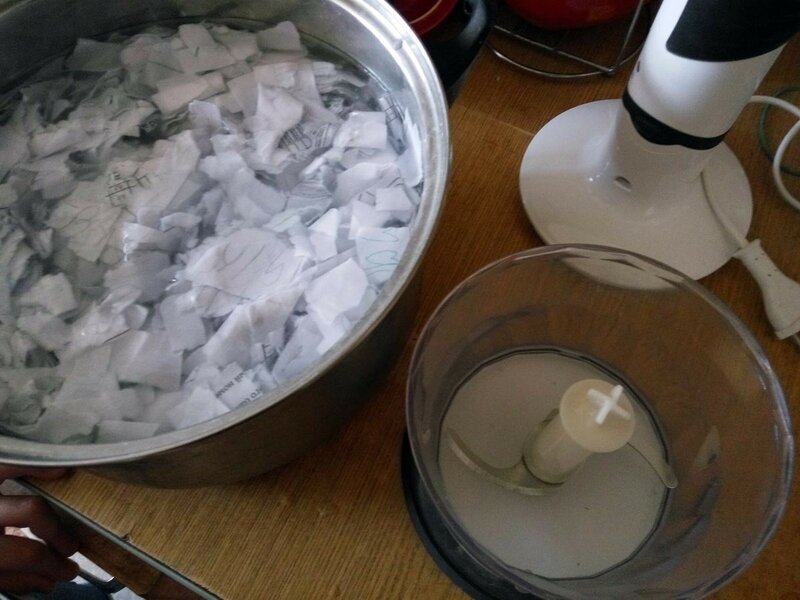
It turns out to be such a mess of grayish-colored fibers due to the fact that the paper was covered with pencils and felt-tip pens. You can try bleaching, there are recommendations on the Internet. I haven’t tried it myself yet, since they then paint on paper with acrylic and the color is not particularly important. It is also recommended to add starch or PVA glue for elasticity. I can do without them too. You can add dye and decorative elements.

Actually, everything is ready to form sheets of new paper: fiber, frame, bowl of water, sponge, cloth for drying the paper.

2 FORMATION of sheet.

We connect the frames (with the mesh inside), you can fasten them with rubber bands, this makes them easier to hold and they will not move among themselves. Take a little fiber and stir it evenly throughout the entire volume in a bowl of water.

Use a frame to scoop up water with fiber and do not remove it from the water for a while so that the fiber settles on the mesh. The thickness of the paper will depend on the amount of fiber caught on the mesh.
The VIDEO below shows the process (at 57 seconds).

Smoothly remove the frame and let the water drain. If we see that the sheet is not uniform in thickness, shake the fiber back and repeat the process.


Carefully remove the top frame. Do not touch the fiber; imprints may remain on the future paper.

We turn the frame over onto the fabric and use a sponge to remove excess water, lightly pressing the mass to compact it. We remove the water until the sponge stops absorbing.
The VIDEO below shows the process (at 1 minute 17 seconds).

Remove the frame. The sheet should remain on the fabric.

A well-wrung and pressed sheet can be easily picked up. This is in case the paper does not “want” to lag behind the grid.

Cover the sheet of paper with several layers of fabric and repeat the process. The texture of the future sheet will depend on the texture of the fabric. You can take material with a waffle pattern and the sheet will be in a small square. Make sure there are no folds in the fabric, otherwise the print will remain on the paper.


Finally, cover the sheets with something flat and place them under a weight.
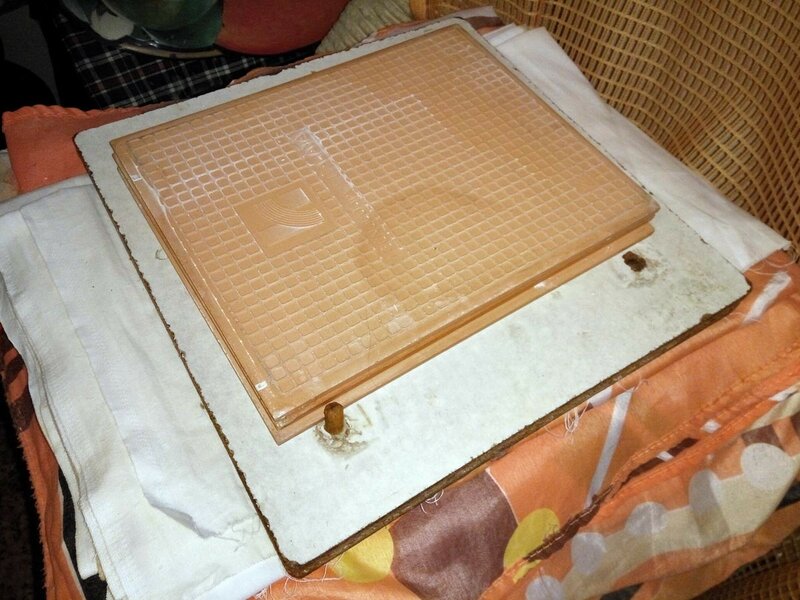
3 DRYING

The paper dries under the press for several days. When drying without a press, the paper will bend.
You can speed up the process by occasionally changing the fabric to a dry one. If you have time, you can iron dry between layers of fabric. It is necessary to ensure that there are no folds in the material and periodically turn the sheet along with the fabric for uniform drying, since the bottom will be wetter. Do not make the iron too hot; the paper may turn yellow. I want to try using a photo glosser.
To the light

Fingerprints are visible when the child touched the fiber on the mesh. Although, you can play with this, for example, make a palm print and then draw a portrait or glue a photo.

If you dry it under a layer of fabric with a waffle pattern, it will print.

The sheet is quite elastic.
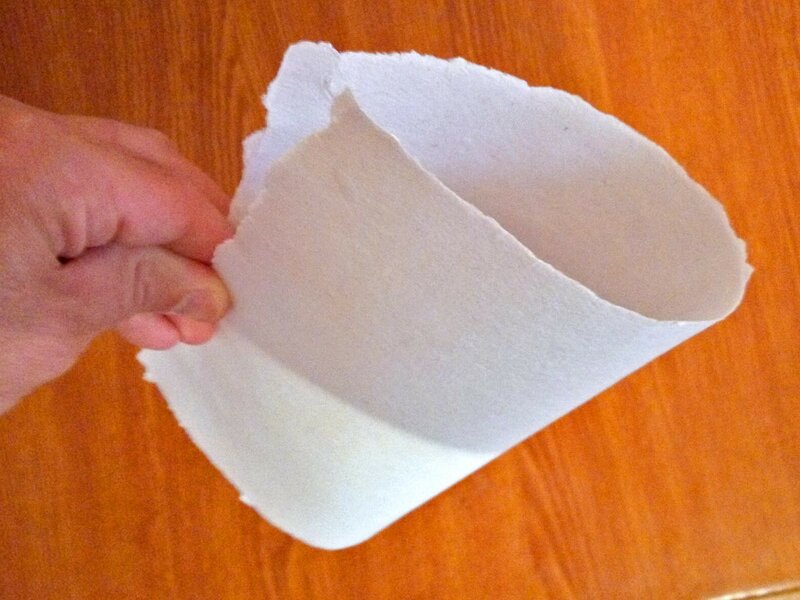
Ready-made sheets of paper.

From 70 sheets of old A4 paper we got 23 new thick sheets and from the remnants of the fiber such a helmet)))

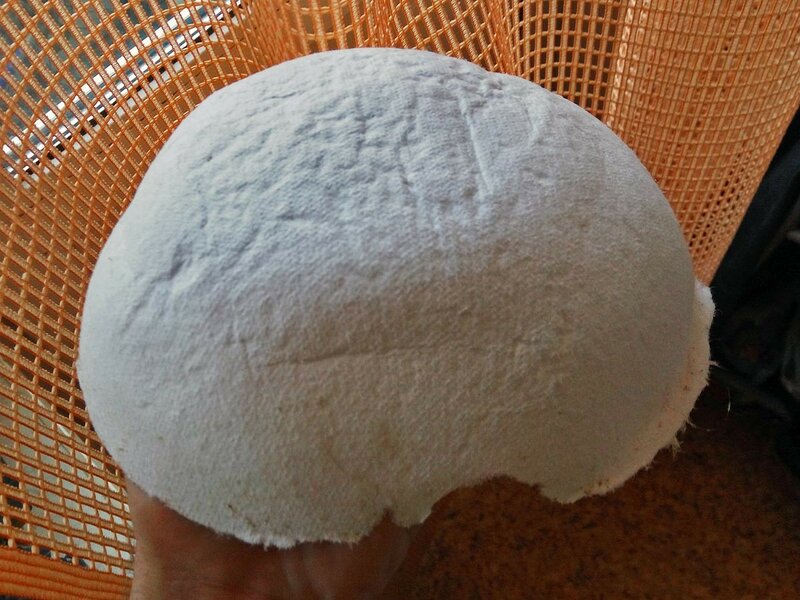

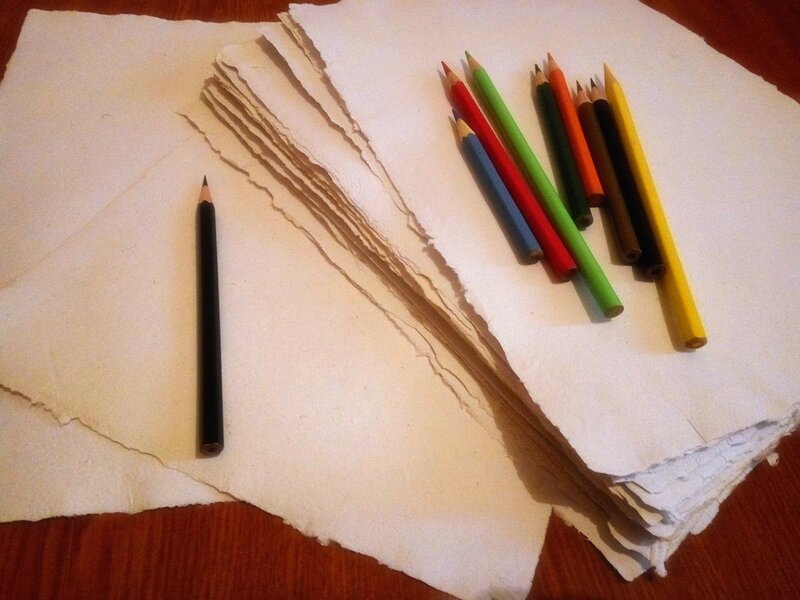
All of the above in a short VIDEO
§
On May 28-29, the “Motley Sky” festival was held on the Lower Tsaritsynsky Pond, organized by the club of kite lovers PROKITE.
Having seen enough of the kites soaring in the sky from the window of the house on Saturday, I decided to come in for half an hour, but ended up hanging out for two hours.
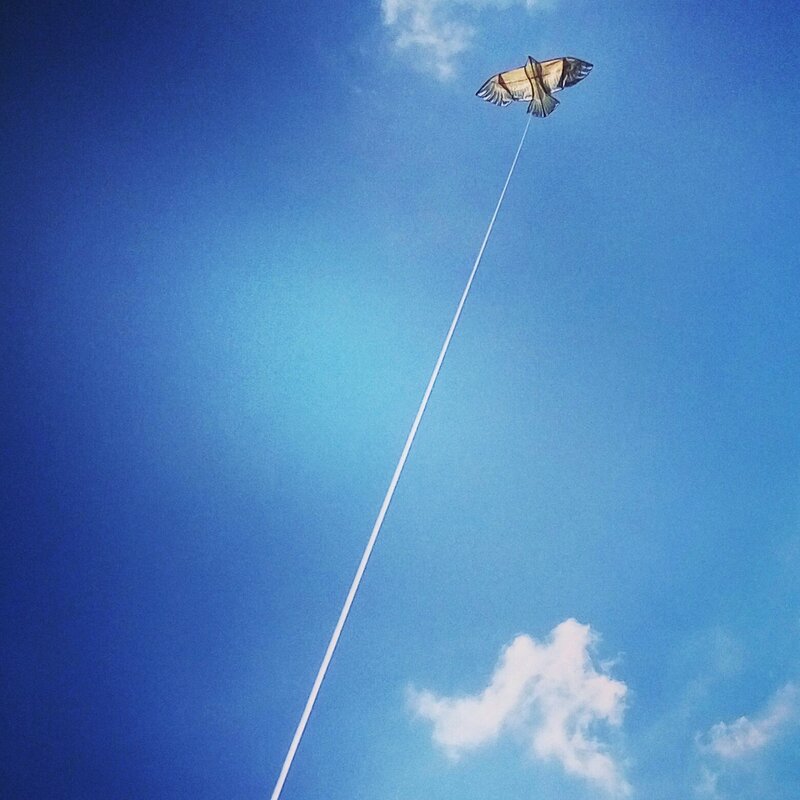
Festival program:
– Flying show kites
– Wind garden, ground installations
– Kite flying by visitors
– Master class on making kites
– Fighting with traditional Japanese Rokkaku snakes
– Demonstration performances on sports aerobatic kites
Lower Tsaritsynsky pond. The weather for the weekend was beautiful.

Festival site.
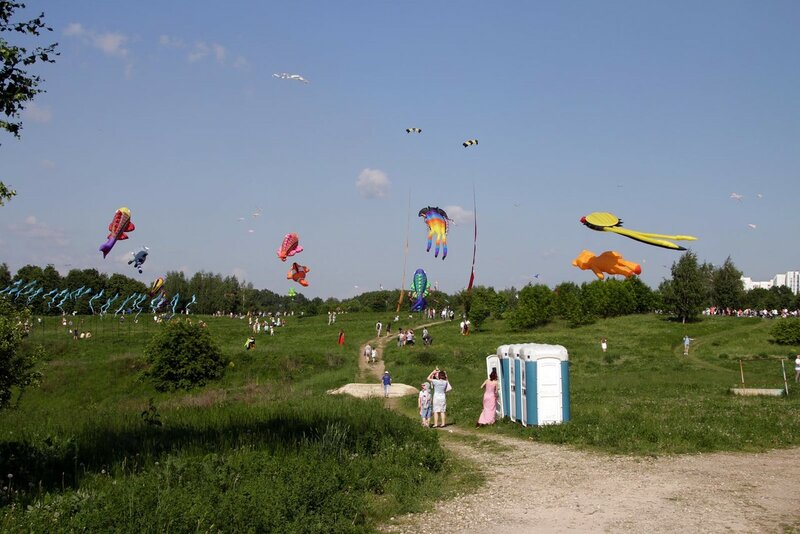
You can buy a kite here. The price range when I bought it was from 600 to 1500 rubles. Water, juices, ice cream, and coffee are also sold. There is a small inflatable trampoline for children. It is better to take water with you, since the area is open and there is no shade. It wouldn’t hurt to take a blanket, lie in the shade of the trees along the edges of the site and admire the kites being flown.

Ground installations




Smiling devil

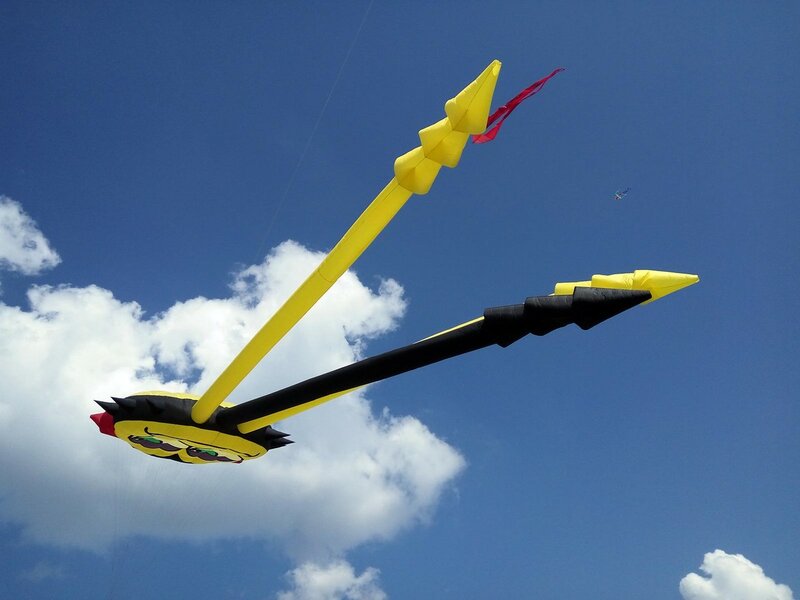
To represent the scale

Pteradactyl

Fish



Cats love fish


The bear is launched. Dimensions again)




Frog
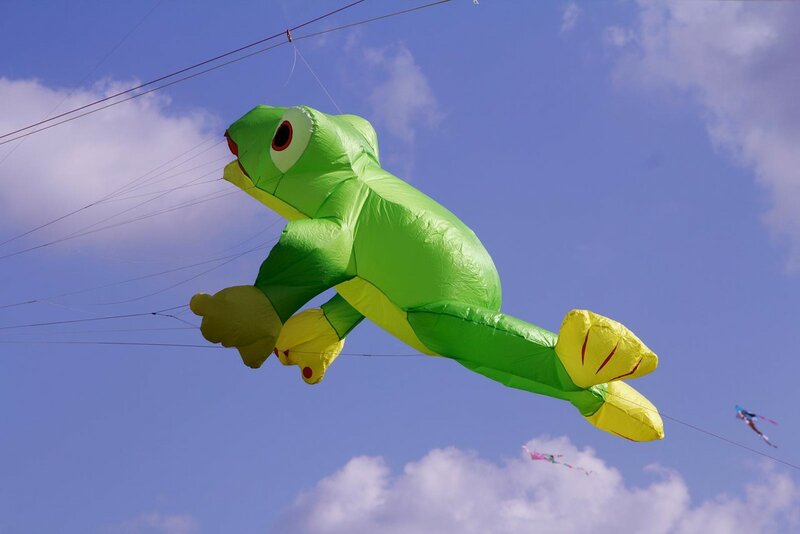
and an unknown animal

Organizers at work


and on vacation
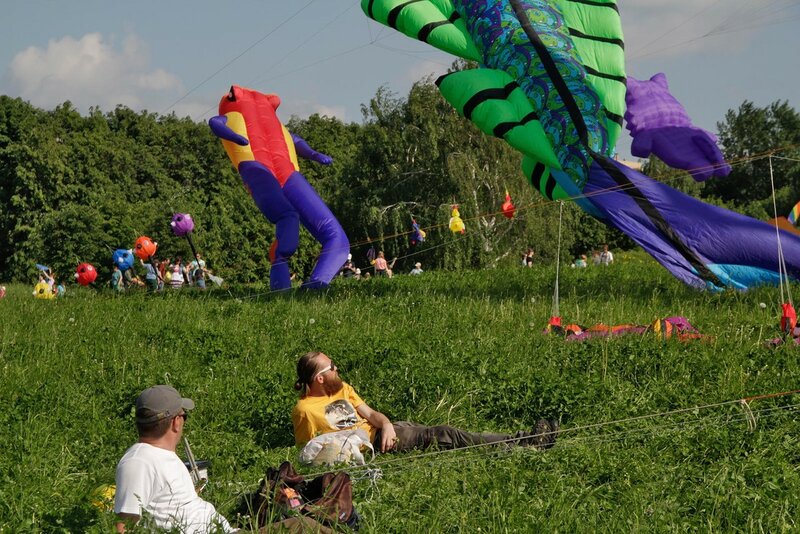

Children and snakes
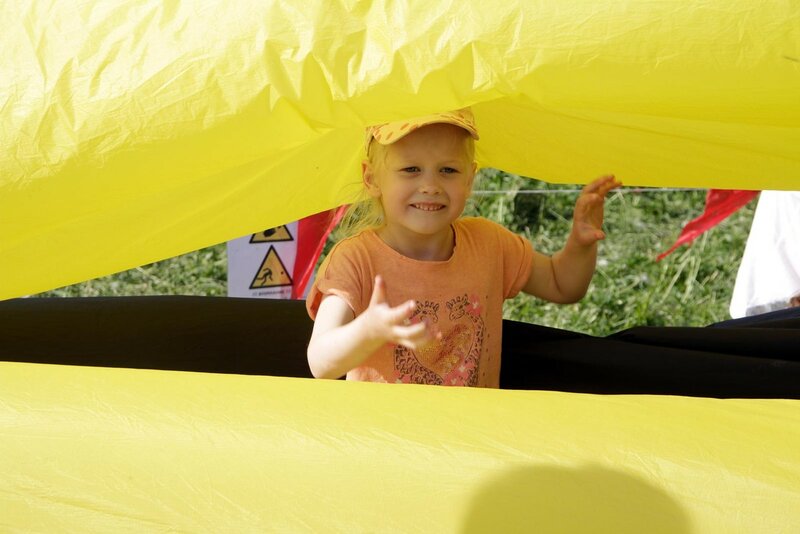

Wind Garden



People and snakes. Some brought it with them, some bought it on the spot.



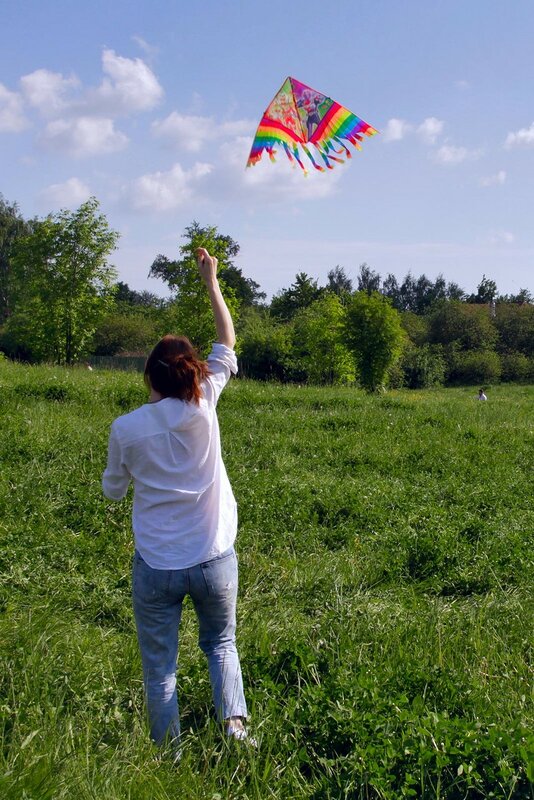
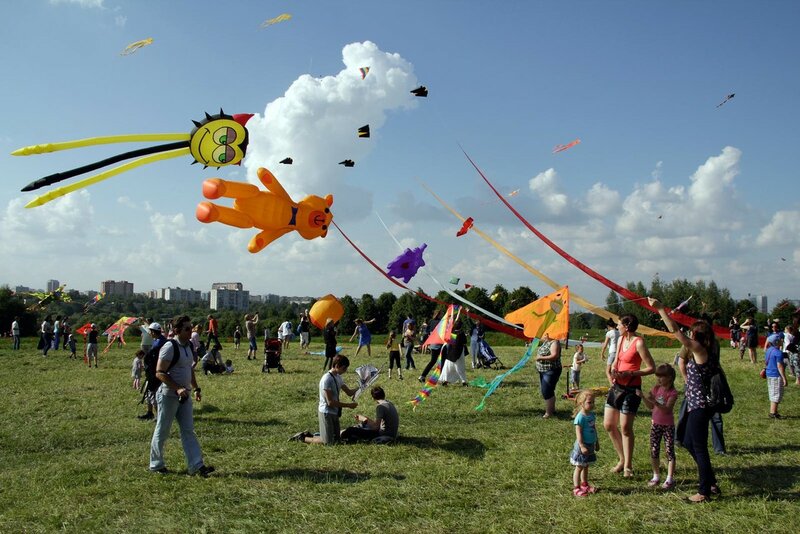
Snakes snakes



There were some original ones
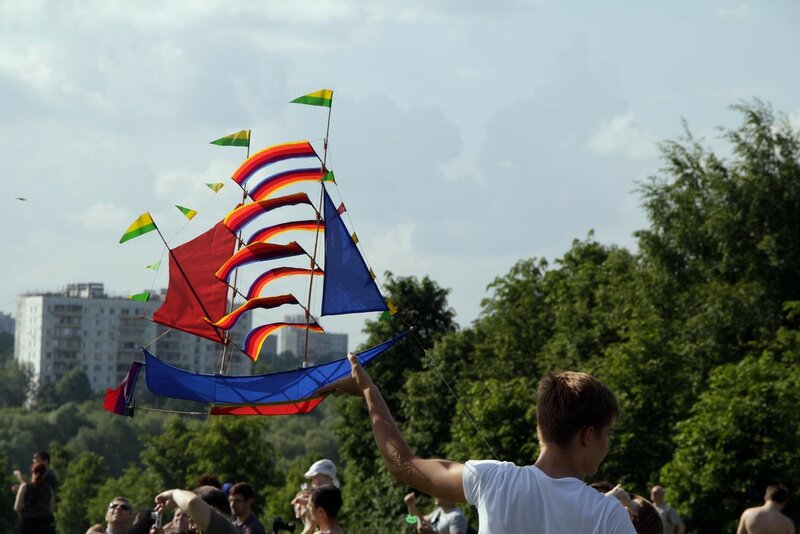
– fly to me snakes

My Owl 🙂
I couldn’t resist and bought it. Wingspan is about 160 cm.

Schoolgirls asked to fly a kite. We were happy. True, the organizers’ kite caught on the cable. The ropes got tangled, my owl broke and she safely fell to the ground.
You can look at fire, water and a flying kite for a long time)
Club team performance – aerobatic kite ballet.
website of the organizers
The festival takes place annually in late May and autumn.
How to get there:
– By car:
Novotsaritsynskoe highway. Watch for the signs. You can’t park everywhere, there is a tow truck.
– On foot:
From the Tsaritsyno metro station – 1st car from the center. Further, along the underground passage to the left until the very end. Go right under the railway bridge. Behind it, at the pedestrian crossing, turn left and walk along Novotsaritsynskoye Highway. Before reaching the Novotsaritsynskoe Highway bus stop, turn left and go out into the field along the road.
From Orekhovo metro station – the last car from the center, exit to Tsaritsyno Park. Enter the park through checkpoint 8 and turn right or to the right through checkpoint 9 “Orangereinye Gate” and go straight. Exit through checkpoint 11 “Chernogryazskie Gate”, cross the road and go left. After the bus stop “Novotsaritsynskoye Highway”, turn right and follow the road out into the field.
…or along Shipilovsky Proezd to Novotsaritsynskoe Highway and turn left along it.
– By bus:
From the Orekhovo metro station – the last car from the center, exit to the Orekhovo bus station. Bus No. 151 to the “Novotsaritsynskoye Shosse” stop. After the stop, turn right and follow the road into the field.

§
Imagine the picture. You come to your dacha in the spring with your family and start voting whether to mow the lawn this year as usual or let it grow.
This is what is happening now on the Active Citizen portal.

As reports
Moscow City Hall in the project “Active Citizen”
The results of the seventh week of voting “Your lawn – your rules!” have been summed up. The majority of Muscovites are in favor of maintaining the current lawn care regulations, that is, regular mowing.
In total, as of July 12, 193,263 project users took part in the voting. Of these, 121,501 (62.87%) believe that lawn grass should be mowed regularly. There are half as many opponents of mowing – 55,417 users (28.67%).
An experiment on choosing lawn mowing rules is being conducted for the summer of 2021. If at least 100 people in one yard express their opinion and more than 70 percent of them choose an option that differs from the current regulations, then the lawn there will begin to be mowed according to the new rules. If the balance of votes changes during the electronic referendum, the current mowing regulations will be restored.
It’s just some kind of circus. Today we mow, tomorrow we don’t. There are technologies that have been proven for decades. You just have to stick to them. Why reinvent the wheel?
So to mow or not to mow? And how often to mow? And if you don’t mow, then what will happen.
With regular trimming, the plants will take on a dwarf shape and, instead of increasing leaf mass, will produce new shoots, creating a dense turf. If you cut it rarely and immediately short, the grass will weaken and begin to fall out, and in its place separate islands will form (as in the photo on the left. This lawn is three years old and has hardly been cut for the last two).
According to Rules for the creation, maintenance and protection of green spaces in the city of Moscow
in paragraph Lawn maintenance
says:
4.2.10. Parterre lawns are cut (mowed) at least once every 10 days at a grass stand height of 6-10 cm. The height of the remaining grass stand is 3-5 cm. Each subsequent mowing is carried out in a direction perpendicular to the direction of the previous mowing.
4.2.11. Ordinary lawns, including those in residential areas, are mowed when the grass height is 10-15 cm every 10-15 days. The height of the grass left is 5-8 cm.
4.2.12. Meadow lawns in parks and forest parks, created on the basis of natural meadow vegetation, depending on the purpose, are left in the form of flowering herbs or maintained as ordinary lawns.
4.2.13. Meadow tall grass lawns created on the basis of natural grassy vegetation should be mowed no more than once a year and no more than 30-50% of their surface.
Opponents can understand how it’s done, it’s better to let it overgrow.
What the Resident does with the construction and maintenance of lawns in their yards is a separate topic for discussion.
In addition, wet grass is not cut in the rain, and Mowing lawns with trimmers is not allowed!
§
Like
reports
Gismeteo: In less than a day, at 16:30 local time on August 15, the amount of precipitation at the Balchug weather station reached 100 mm. This is the first case of such intense precipitation in the history of meteorological observations in Moscow.
Walked around Tsaritsyno.

Parking dead end on Sevanskaya 7 k1


Sosenki Park

New asphalt in the park. It would seem that you can rejoice. But it feels like it was being compacted with feet.

A section of new asphalt in front of the old one has formed a kind of dam that prevents water from flowing down.

Typical courtyard

Due to problems with the collector (under repair), Kaspiyskaya Street in the area of building 22 k1 was flooded. Traffic was blocked.
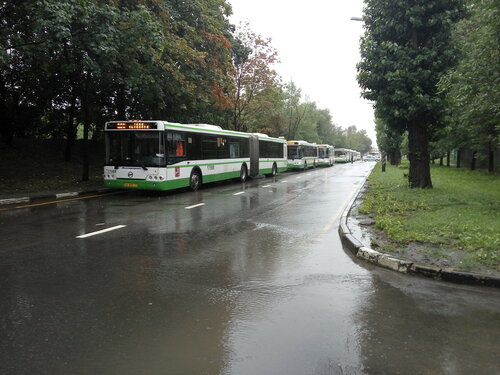
The smell of rotting sludge (not sewage as some media write) permeated the entire area



Water can be seen escaping from the sewer. Near the house 24 k1 on Kaspiyskaya.


New asphalt on Luganskaya. Due to the layout of the road, water does not flow to the edges but spreads over the entire plane.

New storm sewer drains for the kindergarten at Bekhtereva 37 k5. The renovation should be completed in July 2021. Construction is ongoing.

As a result, of the three new storm drains, none of them work. There are simply two wells above the asphalt level and the water flows safely around it.


and the third one simply choked

This causes the water to flow down the path through the dog run to the pond.

The problematic drainage at school 868 has not yet begun to be repaired. At the opposite end of the school, judging by the silt on the asphalt (very odorous), it became clear that water had escaped from the collector to the surface.

And so, the water from the kindergarten flows into the ravine of Arshinovsky Park

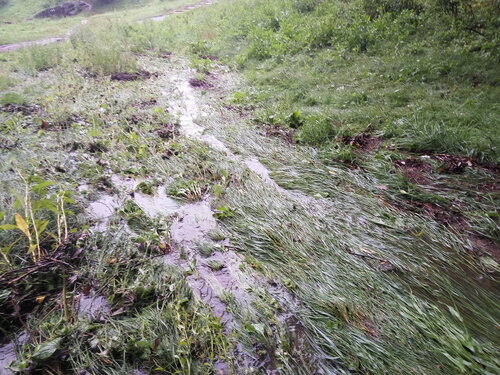
Plus, ill-conceived drainage along the path running along the ravine past the pond


Result


The sand and gravel mixture is washed into the pond

Another problem area of Arshinovsky Park is the drainage system in the depression near school 868 and kindergarten 1168.

Drainage goes under the path. Everything’s alright here

Login

Exit

Yes. Now we can say that we survived the heaviest rain))) We can only hope that the relevant services will take note of what he did

And finally, the other end of Moscow. Polezhaevskaya.
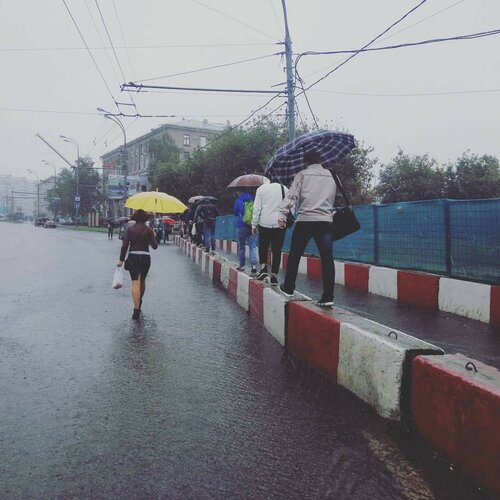
Flooding on Andropov Avenue
Caucasian Boulevard
§
I bought myself toys:
Telephoto lens x8 LeiQI LQ-007 on a clothespin for 990 rubles and a Universal 3 in 1 lens (Macro Wide Fisheye) on a clothespin for 590 rubles. Suitable for any smartphone.
Tested on Xiaomi Redmi Note 3 with a 13 MP camera

I’ll tell you the general disadvantages right away: you won’t be able to quickly attach a clothespin to your phone and get any of these lenses into the center of the camera. You have to carefully move it to align the optical axes; and The phone camera sees the lens rim.
All photos are originals.
TV movie.
Will make your smartphone a real male. For comparison, I put it on an iPhone

Has a focus ring. To photograph an object close or far away, you have to rotate it, which is impossible to do without holding the lens, since it moves from the optical axis (I wrote at the beginning). Here are the options: either rely on the strength of the clothespin and hold the lens with both hands while adjusting the sharpness, or come up with a tricky grip so that you can hold both the smartphone and the lens with one hand. For my Xiaomi shovel, the mounting option is only on top; for those who have a camera that is not in the center or a small smartphone, you can attach the clothespin to the side, then it’s easier to hold it with one hand.

Photo without attachment

Telephoto photo

Photo without attachment 100% magnification

Telephoto photo 100% magnification. Chromatic aberration in contrasting places, the edges of the frame are blurred and positive “cushion” distortion (will make you look slimmer :)) The magnification is still better than x4 on the phone. 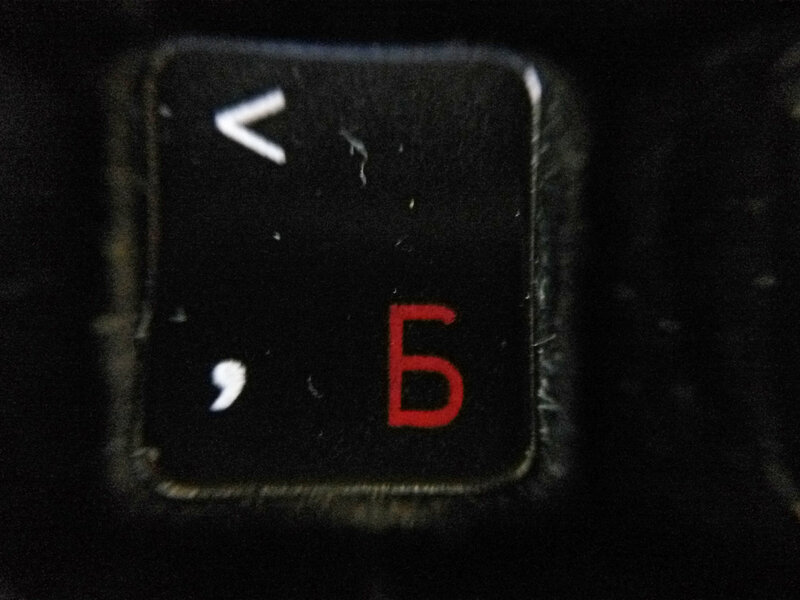
The minimum focusing distance from the matrix plane is about 55 cm, the background is not poorly blurred.
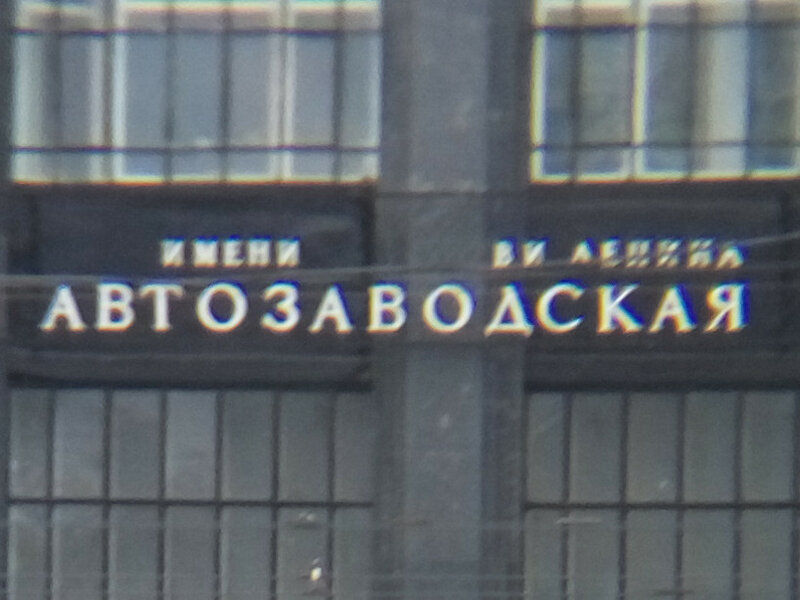
blinds for visibility

Universal lens 3 in 1 (Macro Wide Fisheye)

Let’s start with Fisheye (pictured left). This pampering is complete and unnecessary.

Photo without attachment for comparison

Fisheye 100% increase. No comments.

Wide
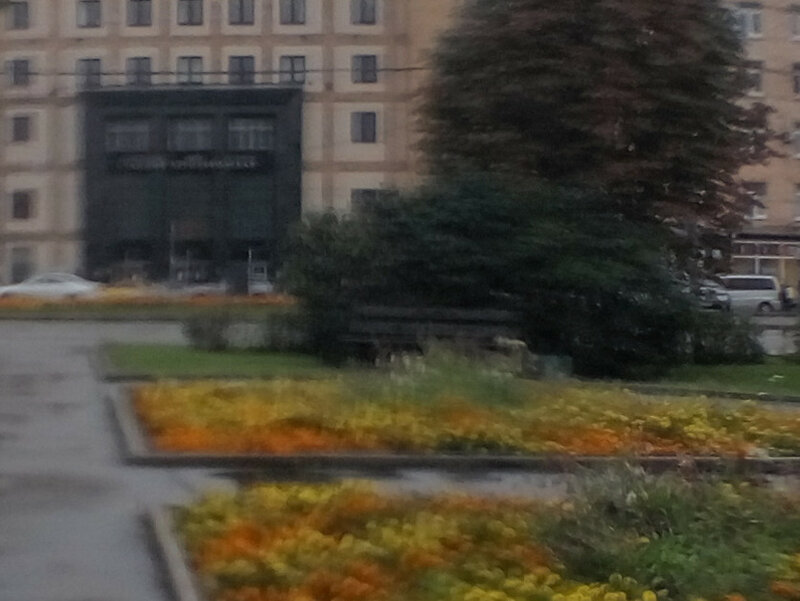
If you really need it, you can use it.

Wide 100% increase

Now let’s crop the edge of the lens that gets into the frame. Apart from the quality, fisheye is almost no different from wide-angle. 
Fisheye
Wide
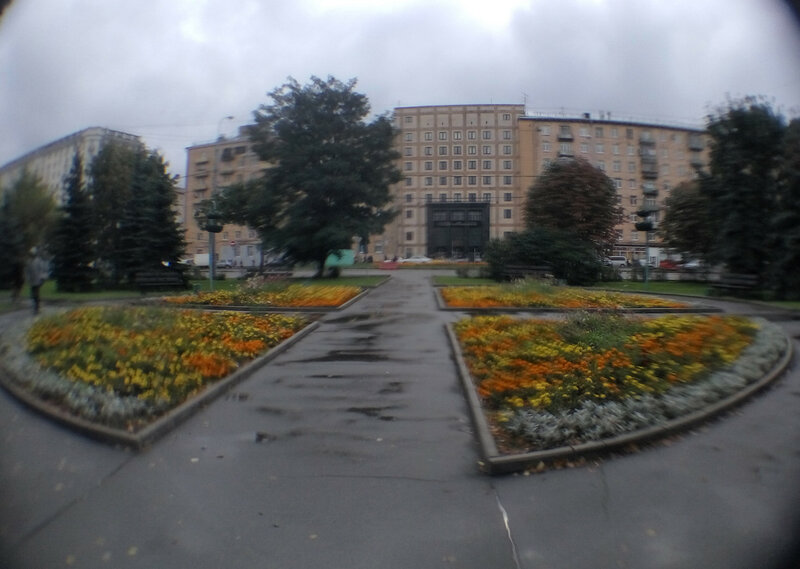
And lastly Macro.
The Wide lens unwinds into two parts, one of which is a macro lens.

For scale, the entire keyboard button fits into the frame.
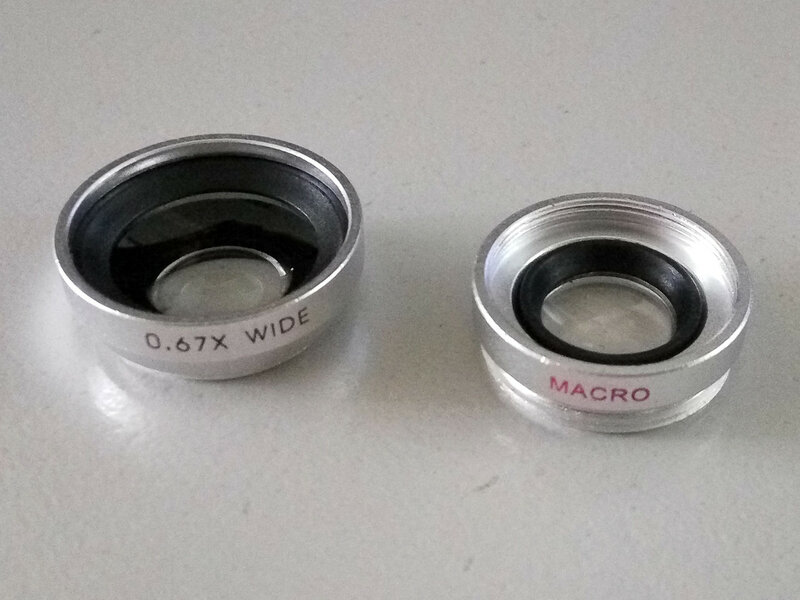
Overall a fun toy and the edges of the frame are clean.


§
I’ll tell you what interesting trees I came across in our area. Write in the comments if you have anything else to add.
The rarest and most interesting thing I have come across so far is the large-leaved linden (Tília platyphyllos f. laciniata) or split-leaved or dissected-leaved.
For several years of working as a dendrologist in Moscow, I saw one like this only in the Botanical Garden. Tsitsin (they say they also saw him in Beskudnikovo).
It is interesting for its deeply and unevenly dissected leaves, which often curl, making the crown look lacy. From a distance it looks like they were gnawed by caterpillars 🙂


Gray bark. The tree is mature, 15cm in diameter, height about 12m.

Grows on the territory of school No. 904, subdivision Kavkazsky Boulevard 37 k2. From the porch (if you are facing it) go to the right, not reaching 10 meters to the gate on the right in the first row.

___
Silver maple (Acer saccharinum) is not often found.
The leaves are deeply lobed, five-lobed on long petioles. The leaves are bright green above and silvery-white below and look spectacular in the wind when the crown begins to turn silver.

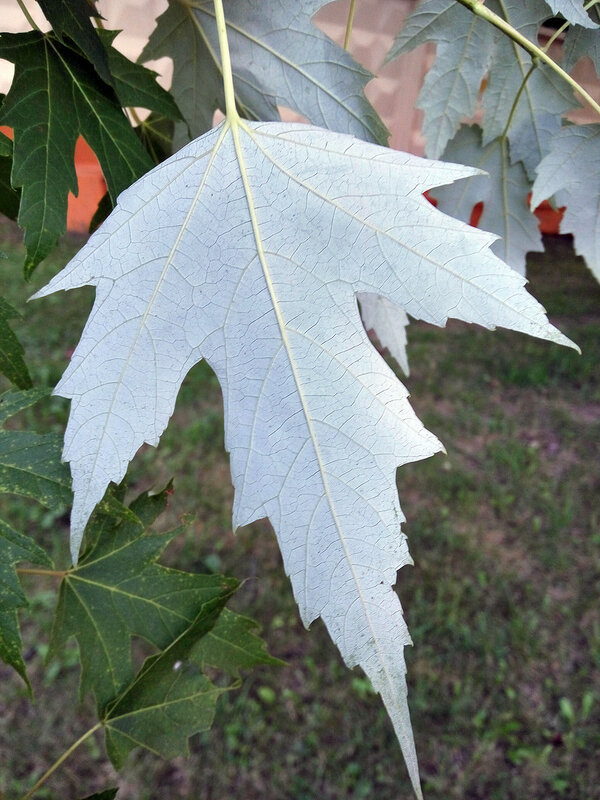
The bark is gray or dark gray, peeling off in large longitudinal plates.
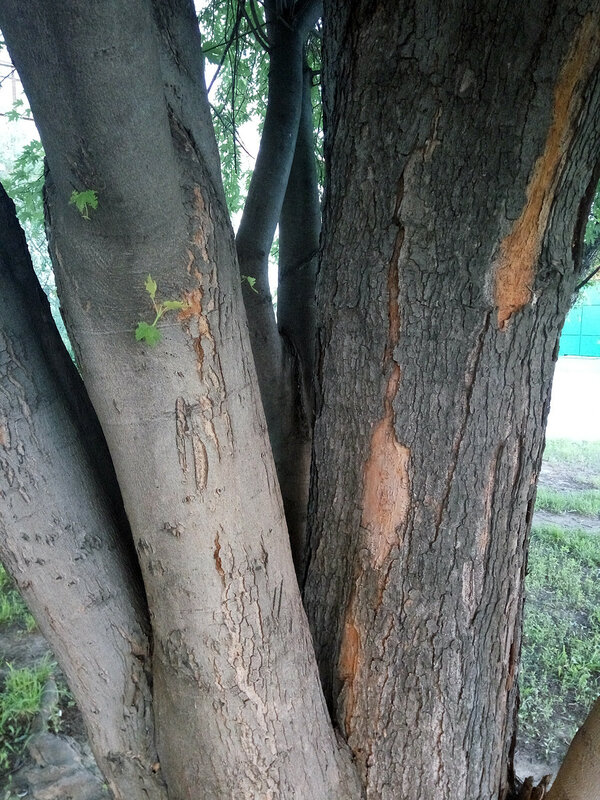
A row of trees grows along the fence of a psychiatric clinic on the side of the house on Bekhtereva Street 13 k1.

Neighbors in Moskvorechye-Saburovo have trees on Kantemirovskaya street 16 k1

Gray spruce (Picea glauca), or Canadian spruce, or white spruce. Comes from North America. Has many decorative varieties. Do not confuse it with Prickly Spruce (Picea pungens), also known as Blue Spruce (which, by the way, can be green). The gray one has shorter needles and smaller cones.

Growing on the territory of a kindergarten on Bekhtereva Street 13 k2

___
Manchurian walnut (Juglans mandshurica) or Dumbey walnut grows in Sosenki Park.
It is a relative of the walnut.

The leaves reach a length of 40-90cm. Why not a palm tree? 🙂

The fruit, popularly called a nut, is a dry drupe from a botanical point of view. The kernel is edible, contains up to 56% oil, and is rich in iodine, but it is not easy to obtain. The shell is very thick, just like a walnut, you can’t open it with a knife. It has a beautiful cross section and is used in arts and crafts.

 The tree produces phytoncides, the fruits and leaves are used in folk medicine. Fresh leaves promote cleansing and healing of wounds (can be applied fresh). They help avoid calluses if you rub your hands with them before work, or when breaking in new shoes, rub your feet. At the dendrology institute, a teacher told me this recipe as a general tonic: the still soft, developing fruits are cut, placed in layers with sugar in a jar and filled with vodka. Take (and not abuse) the resulting infusion.
The tree produces phytoncides, the fruits and leaves are used in folk medicine. Fresh leaves promote cleansing and healing of wounds (can be applied fresh). They help avoid calluses if you rub your hands with them before work, or when breaking in new shoes, rub your feet. At the dendrology institute, a teacher told me this recipe as a general tonic: the still soft, developing fruits are cut, placed in layers with sugar in a jar and filled with vodka. Take (and not abuse) the resulting infusion.

There are five groups growing in the park, with a total of 26 plants. Sit in their shade and heal 🙂

___
Banks Pine (Pinus banksiana) grows in Arshinovsky Park.
Named after the English naturalist and botanist Joseph Banks (1743-1820). The needles are much shorter than those of Scots pine. The cones are small, curved, with a pointed end, up to 4.5 cm long, remain unopened on the tree for a long time and hang for several years. Several trees grow along the fence of Hospital No. 12.
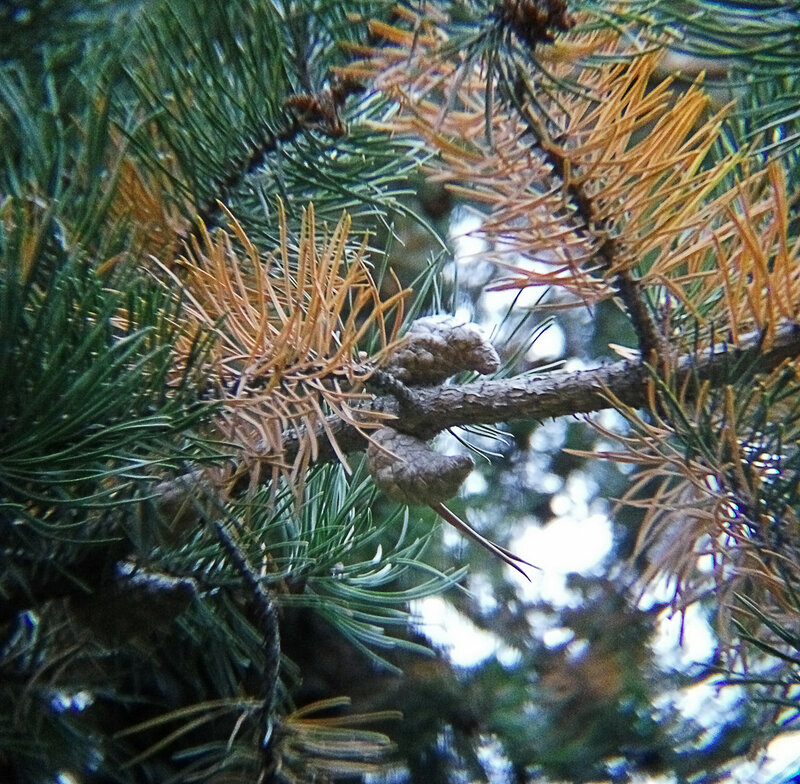
___
Siberian pine (Pinus sibirica) or Siberian cedar grows nearby.
People incorrectly call it cedar. Scientifically, this species belongs to the genus Pine and is a close relative of Scots pine, not true cedars. The needles of the cedar pine are located in bunches of five pieces, unlike the ordinary ones of two pieces. They say it bears fruit, but I haven’t seen any cones yet.


Cedar pine on the left, banksa on the right

___
I came across one of the largest Balsam Poplars (Populus balsamifera) behind the house on Sevanskaya Street 11. It grows near a transformer booth. Its diameter is 145cm, height is about 38m.

either I’m skinny or the poplar is fat 🙂

A large smooth elm (Ulmus laevis) or common elm grows nearby. Its diameter is 85cm, height is about 32m.


Poplar on the left, elm on the right
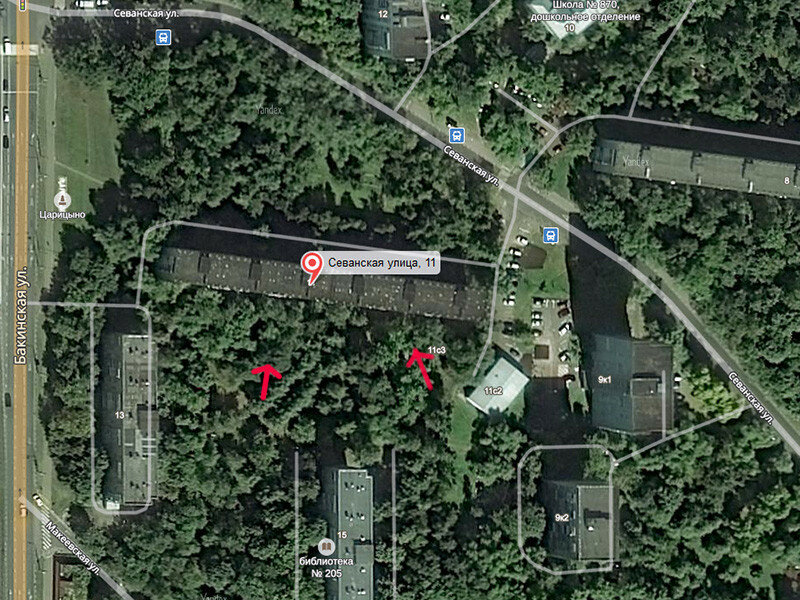
___
Near the house on Sevanskaya street 46 k1 there is a balsam poplar with a name plate: “This poplar was planted in 1936 by B. I. Holdevich,” that is, it is already over 80 years old, taking into account its age

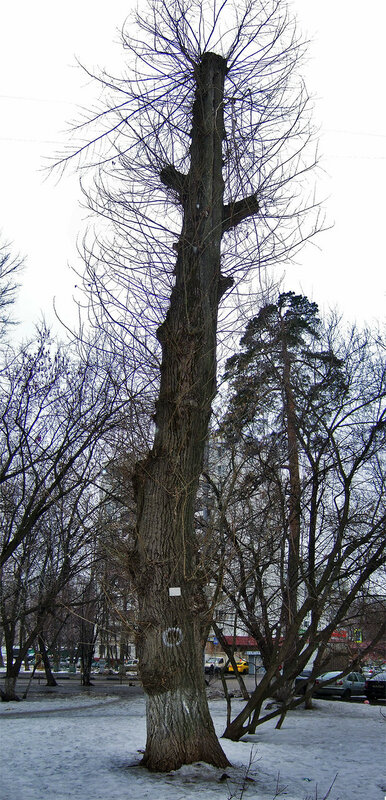
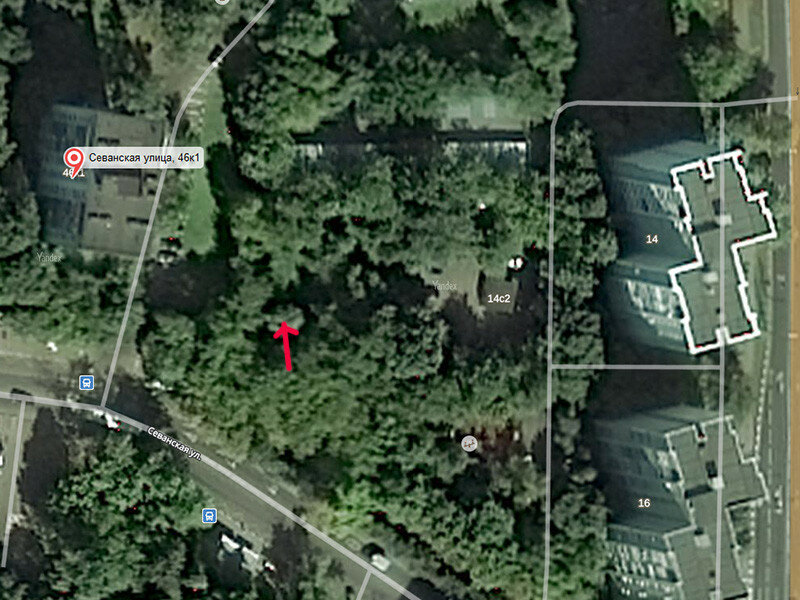
___
Robinia pseudoacacia or Robinia pseudoacacia, or Robinia pseudoacacia, or common locust.
A tree or tree-like shrub that is quite common in the area. I would like to tell you about the name. It is mistakenly called “white acacia”. It is also not correct to call the common caragana tree shrub “yellow acacia”. Although they and acacia belong to the same legume family, they are representatives of different genera. Acacia is an evergreen plant and does not grow in our latitudes.
The plant was named by Carl Linnaeus in honor of the French father and son botanists Jean Robin and Vespasian Robin. Comes from North America.
Among the interesting facts: Robinia pseudoacacia is included in the hundred most dangerous alien species in the flora of Europe. The plant is an invasive species that changes the activity of the local ecosystem, disrupting the nitrogen cycle in the soil. But this is more relevant for the southern regions.
In the Biryulyovsky Arboretum there is a whole alley of Robinia. Blooms in late May early June.

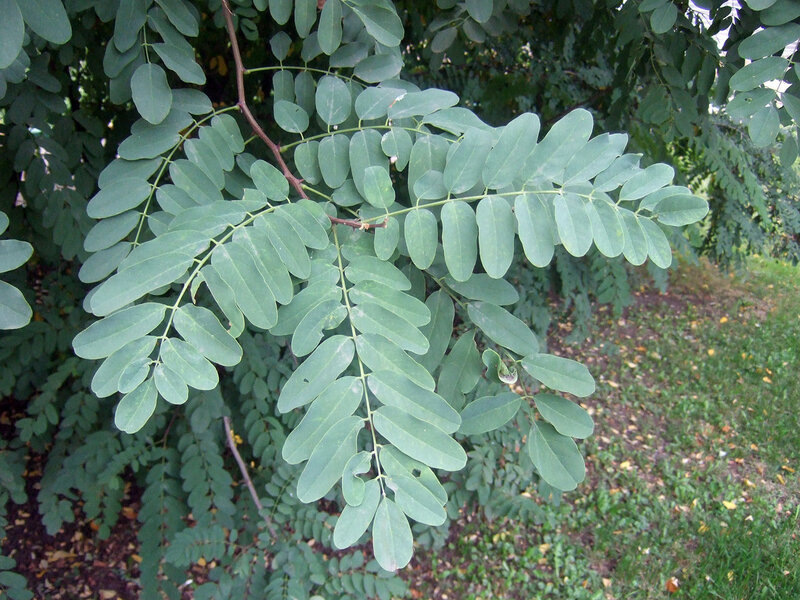


___
Very rare in Moscow Amur Velvet (Phellodendron amurense) or Amur Phellodendron, or Amur cork tree.
I haven’t seen it in the area, but there are several trees in Tsaritsyno Park.
Homeland Far East. It is interesting for its bark, the outer layer of which is velvety and consists of a thick layer of cork. The bark is very pleasant to the touch. Velvet belongs to relict plants that grew before glaciation; these are living monuments of nature.

___
False-platan maple (Acer pseudoplatanus) or pseudo-sycamore, or white, or sycamore.
I didn’t come across one in the area either, I saw it in Tsaritsyno Park.
As Wiki writes, sycamore was the legendary material from which harp was made, interpreting the stable epic expression “little harp” as originally meaning “made from sycamore.” Perhaps this word in Slavic languages sometimes meant maple in general (maple forest).

Leaves are dark green or purple in color.


___
Not a rare but interesting tree: Maaka bird cherry (Prunus maackii) or ferruginous cherry, glandular cherry, ferruginous cherry, bear’s bird cherry.
The plant is named after the Russian naturalist, explorer of Siberia and the Far East Richard Karlovich Maack, where it actually comes from.
It is notable for its elegant bark, reddish-orange or golden-yellow, smooth, shiny, flaking across the trunk in papery, thin films. In dense shady plantings, the color of the trunks is not as bright as in the light, which is what is observed in the park. In the Biryulyovsky Arboretum these trees are more colorful. The fruits are not edible, very bitter.
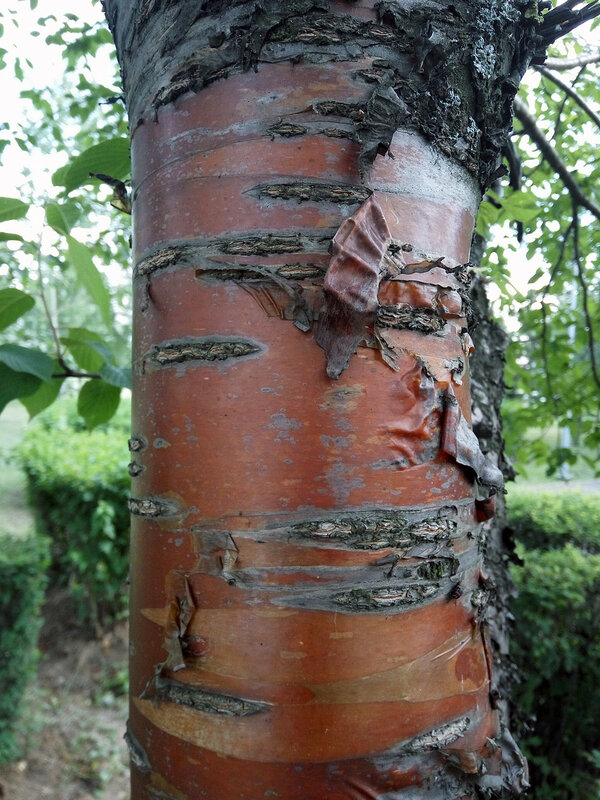
1 Amur velvet
2 False sycamore maple
3 Bird cherry maaka

___
And finally, an interesting fact about the ubiquitous Acer negundo or American maple.
It is similar to ash, but it is easy to distinguish them: maple has 3 leaf blades (less often 5 or 7), ash has 5-15; The edge of a maple leaf is cut into small lobes, while ash does not. Without leaves: the maple bud is covered with grayish hairs, the ash bud is brown or black.

Maple is native to North America. Intentionally introduced into Europe in the 17th century. Already in the 1920s, its self-seeding in natural conditions began to be observed. Currently, in Russia, ash-leaved maple is a dangerous invasive species. It poses a serious and growing threat to biological diversity. Due to its very high ecological plasticity, it is one of the most aggressive woody weeds in the forest zone of Eurasia, for which traditional methods: cutting and sawing are not effective.
This tree, despite its ability to grow quickly, is not for landscaping. In outdoor plantings it is short-lived and begins to dry up early. The wood and root system are fragile. The trunk is usually always curved. Abundant root growth. The root system and leaf litter, when decomposed, release toxins that inhibit the growth of other plants.
The classic trunk of an American maple: crooked, inclined, covered with burls. A weed in one word.

___
Take care of your mother nature 🙂
Take care of the plants in your yard, don’t wait for it to rain.

§
I don’t remember, at school or college I came up with this character: I started drawing a pig, but instead of a body for some reason I drew a stem and two more bud heads. So the pig flower collected dust in my head all these years, until I accidentally showed it to my child (8 years old). He gave me the task: “draw something.”
– This doesn’t happen.
– It happens. You can make up a fairy tale about him.
Interesting facts about the world around us.

Should we draw a comic based on “The Three Little Pigs”? Since Piglets are specific, then the Wolf, too, should not be simple and the methods of dealing with it are not simple.
This is what we got)) The child said, to be continued:
The child has the right thoughts))
– Do you want to put this on the Internet? Shall we not sell?
1 The Adventures of Pig-ear, Pig-nose and Piglet.
Parasite.
Pigflowers are in danger.

Three Pigflowers grew and bloomed.
– Hello, Pigtail!
– Hello, Pig-ear, Pig-ear!
– Good afternoon guys!
The wind blew and a seed fell nearby.
– What is this?!
– Some kind of seed.
– I hope we will become friends with him.

– How funny!
– Looks like a wolf.
-Are wolves good?
– Hello Goat-Birch! Look who’s arrived.
– Some kind of strange…

At night the seed sprouted…
… and a huge Wolf Fang grew – a parasitic plant

When the Pigflowers were sleeping, the evil Wolf-Fang grabbed their roots with its suction cup roots.
And it began to drink and drink juices, and bloom and smell fragrant, and the Pigflower withered and dried up.

Goat-Birch passed by.
– Wonderful smell!
 And it began to gnaw at the Wolf Fang.
And it began to gnaw at the Wolf Fang.
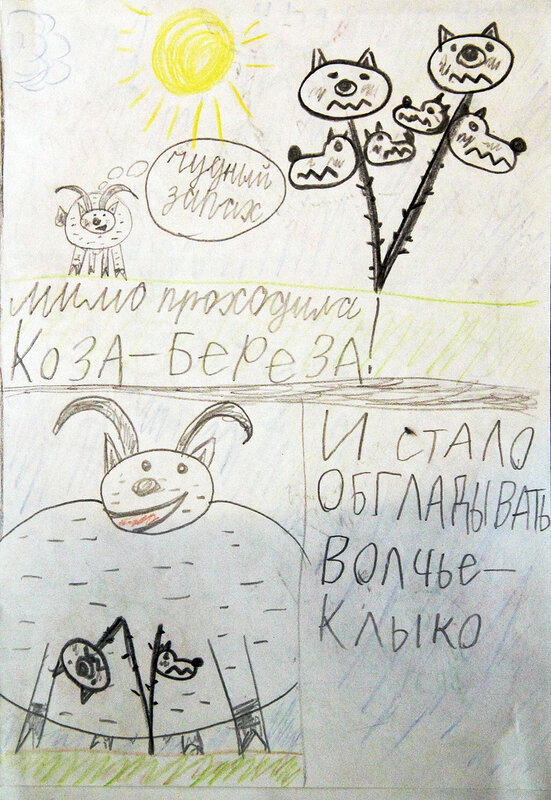
I got so carried away that I tore out the sucker roots.
– It smells like rain. I’ll go home.

The rain passed, the pig flowers bloomed and grew happily ever after.

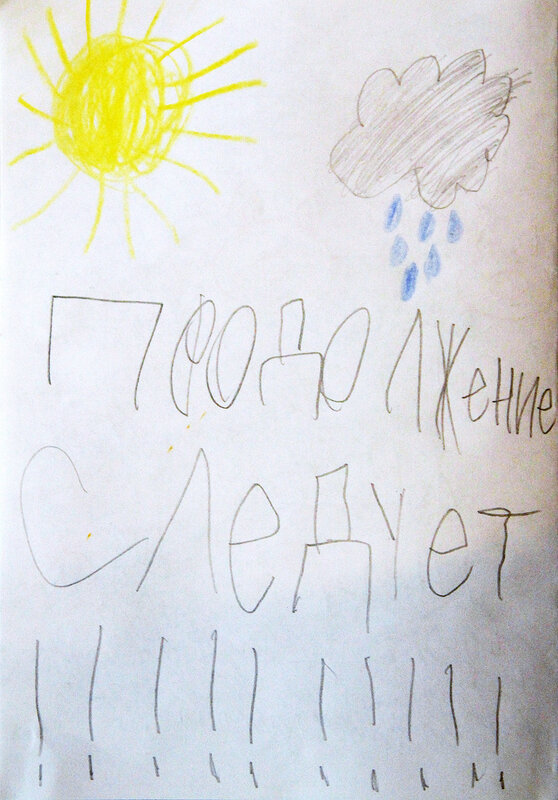
All the adventures of Pigflowers and their friends
Comics
§
Part 2
The Adventures of Pig-Ear, Pig-nose and Piglet.
Guest from the desert.
Pigflowers make new acquaintances and solve the problem of movement.
Interesting facts about the world around us.

– What a wind today!
– LOOK OUT!!!

– Who are you?
– Where are you from?
– Tell about yourself!
– I am Tumbleweed from desert lands. Our feature is a branched stem, like a ball. When the seeds ripen, the stem breaks off and floats in the wind, scattering the seeds. In different places we come from plants of different families: cabbage, cloves… I come from leadaceae.

– Leaded ones?! Maybe we are relatives?
– Tell me about the desert.
– Deserts occupy a quarter of the land surface. The hottest desert is the Sahara in Africa, and the largest is Antarctica. Yes, yes, deserts are not always hot. There are sandy, rocky, snowy ones. In some deserts there has been no rain for decades.
Deserts are not empty at all. Many species of plants and animals live here.

– Plants?!
– Camel thorn is also a tumbleweed. This is a small shrub up to 1 meter high, but with very long roots, up to 20 meters, or even more, to reach water deep underground. Although its stems are covered with thorns, camels love to eat them.

– Camel?
– Camels come with one and two humps. They are called “Ships of the Desert” because, thanks to their wide, two-toed feet, they can move on shifting sand.
Camels can smell water at a distance of up to 60 kilometers and drink up to 100 liters of water at a time. And its humps contain fat, it serves as a supply of nutrition and protects against overheating.
Camels are good swimmers, although most of them have never seen a large body of water.
If a camel goes to sleep, it is very difficult to get him to get up until he wants it.

– I have traveled a lot through deserts. And now I decided to look at your green edges.
– How interesting it is to travel…
– But we are sitting in the ground…

– Pigflowers, why are you so sad and who is this curly-haired one?
– Hello Goat-Birch! This is Tumbleweed, he is a plant, but he can travel. It’s a pity we can’t…
– How amazing!!! What a pity…

– IDEA!!!
– ???!…

– Good luck!
– Go!
– Now you are not afraid of any pests.


All the adventures of Pigflowers and their friends
Comics
§ 
Part 3
The adventures of Pig-ear, Pig-nose and Piglet. 
 Relatives.
Relatives.
Pigflowers get acquainted with all sorts of plants consonant with their name.
Interesting facts about the world around us.

 – Tumbleweed, I have a letter for you.
– Tumbleweed, I have a letter for you.
– This is from my relative from South America.

Photo from letter: Plumbago and Begonia. 
– This is Pig Ear and her friend Pig Ear.
– We are all relatives?!

– No. Lead from the word “Lead” in Latin “Plumbum”. Therefore, our family is also called Plumbago.
– And we nicknamed Begonia Pig’s Ear. She’s from a different family.
– And it really looks like my ears.

 – When I was rolling towards you, I met Svinora at the edge of the forest. I will introduce you.
– When I was rolling towards you, I met Svinora at the edge of the forest. I will introduce you.
Pigweed belongs to the Grass family, like wheat or corn. It has thick rhizome stems with a very sharp and hard end. they can come to the surface of the soil and crawl and take root. And then it can bury itself in the ground again. He digs like a pig with his heel.
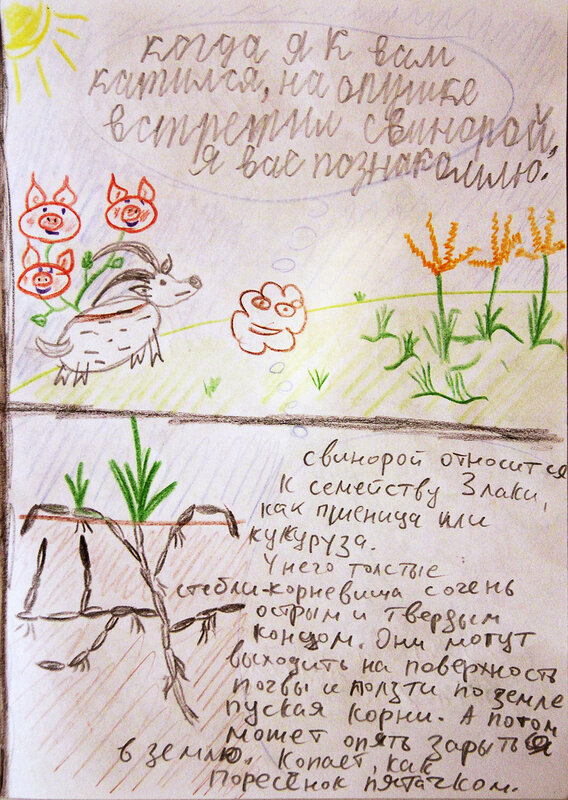
– And in the forest…
– What’s in the forest?!
– Hello! I am mushroom Pig.
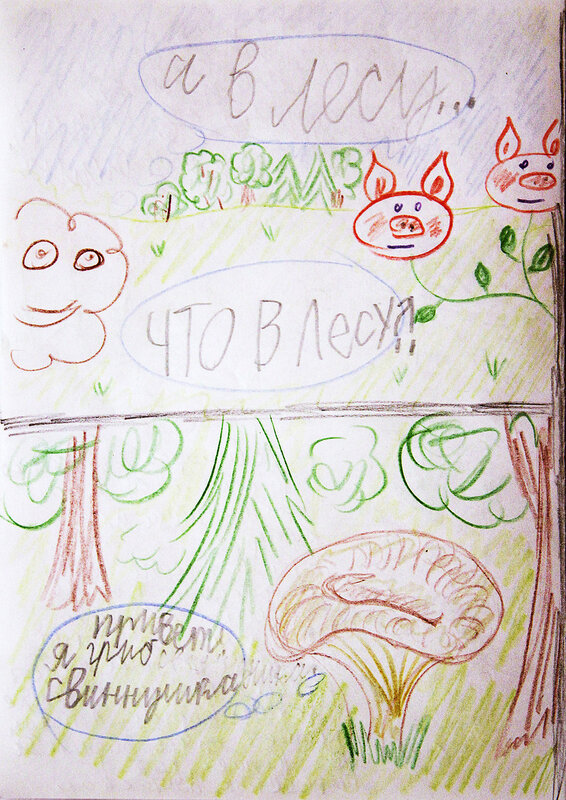
– Ha-ha, Pigflower, you look just like you!
– Well, Goat-Birch, be careful.

Bonus draft of the child 🙂

All the adventures of Pigflowers and their friends
Comics
§
Part 4
The adventures of Pig-Ear, Pig-nose and Svinchatka.
Alien.
It’s not just rain that falls from the sky.
Interesting facts about the world around us.
Got a little carried away by scientific facts. Maybe you need less… Or is it normal? 🙂

– Pigflowers, Tumbleweeds, will you go to my house?
– Let’s go, Goat-Birch!
– I’ll go look at the mail.
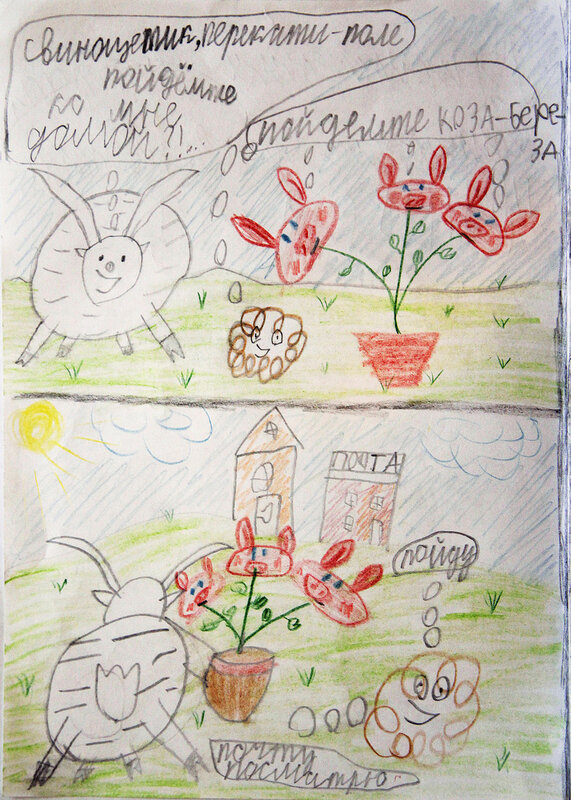
– NEWS!!! There will be a meteor shower tonight!
– Look how long the trail is!!!

BOOM! BANG!
– He fell on the edge!
– Let’s go look!
– What a big hole.
– There’s something there.
– Who are you?

– I am now a METEORITE!
– Who was he?
– I was a METEOROID – this is the name given to small solid bodies flying in space.
Falling onto your planet and passing through the dense atmosphere, I heat up and begin to glow. Have you seen the trail of a “shooting star” in the sky? It’s called METEOR.

Not all meteoroids reach the surface of the planets; many burn up. Those that fell are called METEORITE.
When it collides with the planet’s soil, an Impact Crater is formed. Do you see a round hole with a slide? My job!
From Earth you can see craters on the Moon. The diameter of the Tycho crater is 85 kilometers.
By the way, up to six tons of meteorites fall to Earth per day.
The largest crater on Earth is located in southern Africa. Its diameter is 300 kilometers – this is Vredefort.

– Tell me about space.
– Space is not completely empty space. It contains atoms, molecules, gas, cosmic dust, meteoroids…
The galaxy in which the solar system is located is called the Milky Way.
The shape of galaxies is: spiral, like the Milky Way; elliptical, they look like a circle or ellipse, highly flattened; barred spiral galaxies; irregular shape; lenticular.
How many stars are in each galaxy is unknown.
The exact number of galaxies in the universe is also unknown. There are about two trillion of them
2,000,000,000,000,000 is such a big number.

The closest star to the Sun is Proxima Centauri. It is seven times smaller than the Sun. It is 4.22 light years away. It is far. A light year is not time, but the distance that a ray of light travels in one year and is equal to 9.46 trillion kilometers.
Antares is one of the brightest stars in the night sky and is located in the constellation Scorpio. It is many times larger than the Sun.
– Constellations.
– Since ancient times, people have combined bright stars into constellations for ease of orientation in the starry sky.
It seems that you can’t count the stars, but with the naked eye only about six thousand are visible in the dark sky.
Astronomers identify 88 constellations. From the territory of Russia 54 are visible.

There are constellations that are visible only in one hemisphere of the Earth: the Northern Crown in the northern hemisphere or the Southern Cross in the southern.
Some are visible only in winter, such as Orion, or only in summer, such as Cygnus, Lyra and Eagle. Their brightest stars: Deneb, Vega and Altair form the Great Summer Triangle.
If you take a photograph of the starry sky not in the north with a long shutter speed, you will see that the stars are rotating in a circle, and the North Star will be in the center. It does not move and you can always find out where north is by using it. The North Star is located in the constellation Ursa Minor.
The names of the constellations are associated with real animals: Leo, Fish or fictional ones: Dragon; with mythical heroes: Perseus, Hercules, Cassiopeia; with the names of the objects: Libra, Triangle.

– Wow!!! If only we could go into space!
– … and I won’t be able to fly anymore…
– IDEA!!! Let’s build a rocket and fly!

BOOM! BANG!
– Grab your tools.
– Are you ready to fly?
– YES!

Bonus draft of a child
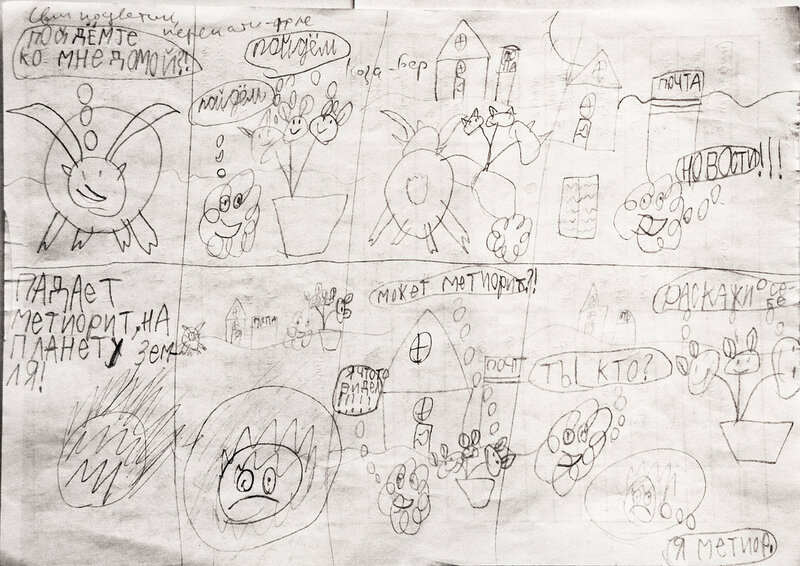
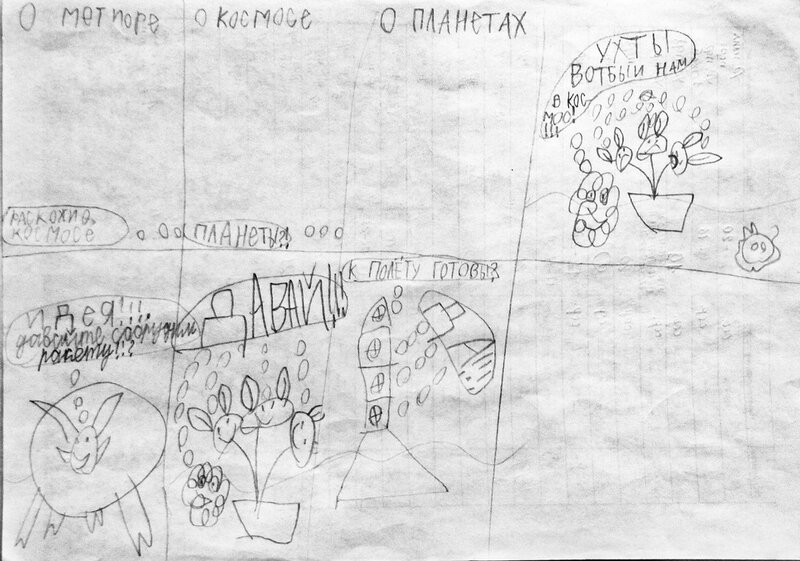
All the adventures of Pigflowers and their friends
Comics
§
In July 2021, Brateevsky Cascade Park located in the Southern Administrative District of Moscow was landscaped. The opening took place, everything was as it should be: a crowd of people, police, frames, music and other balls. Got it,
came
mayor. I was brought into the park itself only a year later.

You can walk along the embankment with a view of Maryino, tiled paths, there are children’s and sports grounds. I especially liked the swings for children with disabilities. According to the idea, you can drive directly onto them with a stroller; a descending ramp is provided. It’s just that you can’t lower it. He is tightly chained.

There is trouble with the seedlings, however, as usual. It is not noticeable that they were looked after. Many died or were clinging to life, looking askance.
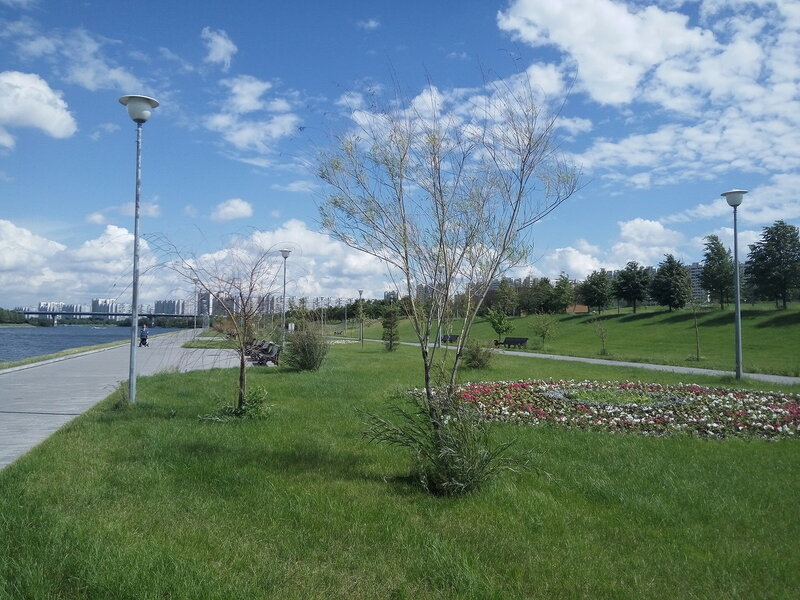



Wikipedia writes: In 2001, during the construction of the Lefortovo tunnel, the Moscow authorities decided to use more than 600 thousand m³ of freed soil for the improvement of Brateevskaya embankment. Three hills were formed on the filled-in area.
The lawn is well-groomed, except for places where you need to swim to it. I noticed that there are problems with drainage. And here, obviously, the recent downpours are not particularly to blame. Stagnant puddles with smell and duckweed are filled with happy ducks swimming.

It looks like the designers miscalculated. Filled soil prevents water from being absorbed. Considering that the relief is lowering towards the river, water flows down the lawn and paths, like dams holding it back. Not everywhere there is water drainage, and where there is, it doesn’t work. As a result, the seedlings stand in puddles and die.




Okay, seedlings. Even alder, a lover of damp places, could not withstand such swampiness. This year, the adult alder tree that found itself in the swamp did not bloom. “The alder grove, lying at the base of the entrance enfilade on the natural bank of the river, is the beginning of the landscape part of the park ensemble,” says the description of the park. Just below the alder grove there is an artificial pond, no wonder the water doesn’t drain away.


And who will be responsible for design errors and improper care of seedlings?

§
I remember: Your children are beautiful, but everything you do with your hands…
Solnechnaya Street in the Tsaritsyno area is finally empty of parked cars coming to work. Now you can drive safely, rather than trying to pass an oncoming car. Parking was prohibited along the entire street, except for the area near the store.
But, according to plate 8.6.5 “Method of parking a vehicle,” stand facing the curb, that is Across
narrow street.
Maybe they don’t know about plate 8.6.8 and 8.6.9? Or were they not in stock? Or is Thinking not our strong point?

It was impossible to leave. Only those standing near the solid road were evacuated.

First, an incomprehensible sign was installed. He didn’t last long at all
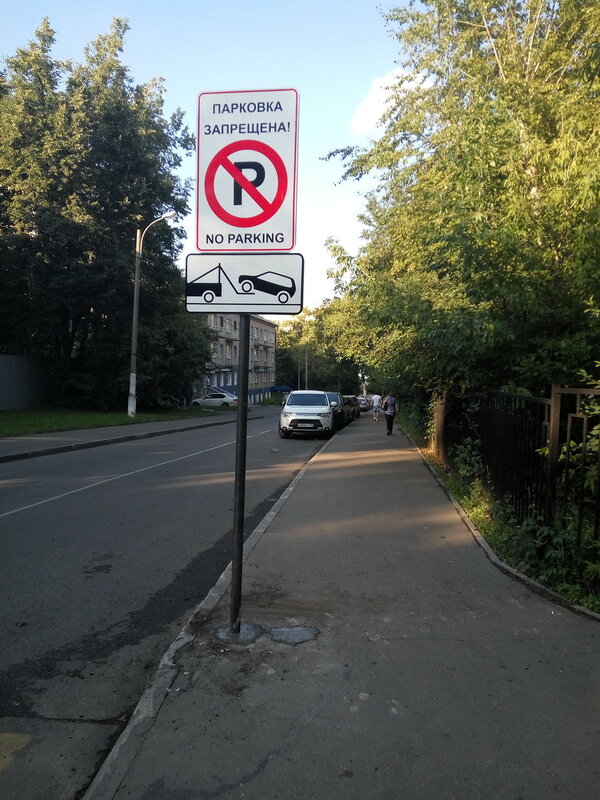
Parking is currently prohibited on both sides of the street
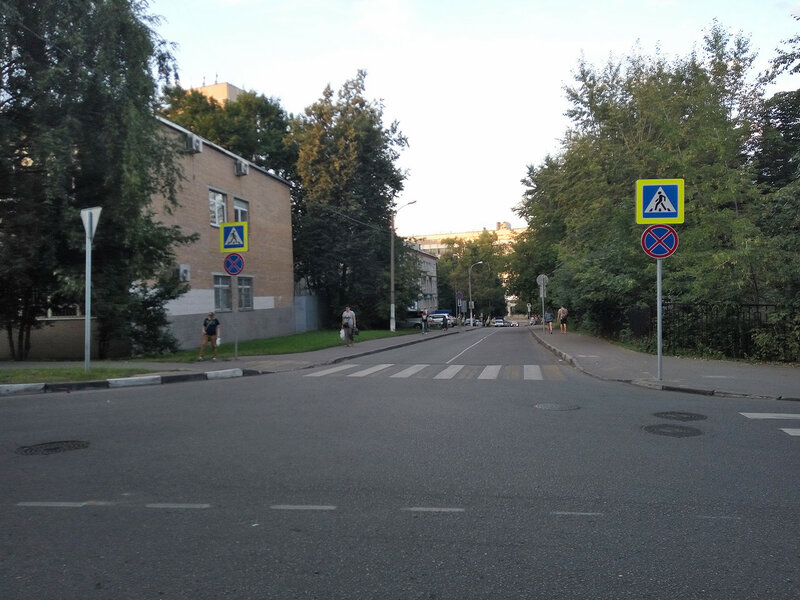
Moscow-Live
§
I drove through the Tsaritsyno district to see the condition of the roads a week after the snowfall, and how the utilities were coping.
We were not primarily interested in the main streets. Therefore, there is no Proletarsky Avenue, Bakinskaya, Luganskaya and Kavkazsky Boulevard streets in passing.
I drove along the streets of Timurovskaya, Veselaya, Tovarisheskaya, Sevanskaya, Bekhtereva, Kantemirovskaya, Medikov, Yerevanskaya, partially Kaspiyskaya, Solnechnaya, Makeevskaya.
In many places, the sidewalks are still not cleared; people are hobbling along the path or roadway. And this is on the main walking routes. You cannot approach the Tsaritsyno metro station from Vesyolaya Street. On the roads, the snow lies in heaps that are not quickly removed, the lanes are narrowed, and in some places it is impossible to get out of parking pockets without a shovel. According to an old winter tradition, Makeevskaya Street is the most snowy.
video sped up
§
I planned a budget vacation for two weeks to take my child and his friend (9 and 10 years old) to the sea. We decided to go to Black and Azov by car and live in campsites. The children were delighted to learn about the tent.
The entire route was 4075: Krasnodar, Goryachiy Klyuch, observation deck in the mountains on M-4, Arkhipo-Osipovka, Pshada with dolmens and a mountain river, Krinitsa, Gelendzhik with a cable car and a Ferris wheel on the mountain, Anapa, salt lake near Veselovka, a spit between the Black Sea and the Kiziltash estuary, the Crimean bridge and cape in Kurortny on the Sea of Azov in Crimea, the Ataman exhibition complex in Taman, the mud volcano Akhtanizovskaya Sopka, Kuchugury on the Sea of Azov and the mud volcano Plevak, Novorossiysk.

First, I will share useful information, and then impressions, photos and details of the trip.
Costs:
Gasoline 95 – 15,356 rubles;
Transponder – 1100 rubles;
Toll road on M4 “Don” – 1383 rubles;
Accommodation – 5580 rubles;
Meals – 14,000 rubles;
Entertainment – 6000 rub.
Road.
Gasoline costs, of course, depend on the car and the number of people. There were three of us, the car was a 95, with an automatic transmission, the air conditioning did not turn off. Average fuel consumption on the highway was 8 l/100 km, on mountain roads it increased to 8.5.
Toll payment.
I decided to buy a transponder so as not to waste time when paying. I’ll say right away that despite the fact that it won’t pay for itself in one trip, it will significantly speed up the journey. We saved 1.5 hours one way.
I looked on the Avtodor website how much the entire road along the M4 Don costs if you pay in cash, it turned out to be 1090 rubles one way daily fare, that is 2180 rubles round trip. I bought the transponder in Moscow at a Lukoil gas station for 1100 rubles. We went through two points at the night rate, and along the entire route there was a 20% discount for the transponder, a total of 1,383 rubles in both directions. As a result, the cost of the transponder/road payment was 2,483 rubles, that is, only 300 rubles more expensive than paying in cash, but we did not stand in queues (at the daily rate and without taking into account the discount, the difference will be 500 rubles).
Gas station.
Along the entire M4 highway there are mainly Lukoil and Transneft. There are significantly fewer gas stations in the Lipetsk region; I almost found myself in an unpleasant situation without fuel. On the way back, I got carried away by the road and did not pay attention to the gauge; when I looked, the computer showed that there was 14 km of fuel left. The navigator showed the nearest gas station 32 km away from the highway. I had to drive slowly, using the gas a little on the hills. Fortunately, I came across a gas station 20 km away.
There are no gas stations between Arkhipo-Osipovka and Gelendzhik.
Beyond Anapa, the closer you are to the road to Crimea, the longer the queue at the gas station.
Traffic jams.
On the way to the sea (Saturday), the Yandex navigator circled part of the “famous” traffic jam in front of Losevo in the Voronezh region along some field roads, as a result, we stood in Losevo for no more than an hour. Locals make extra money by offering to show how to get around traffic jams. The movement on the primer is such that there is a column of dust.
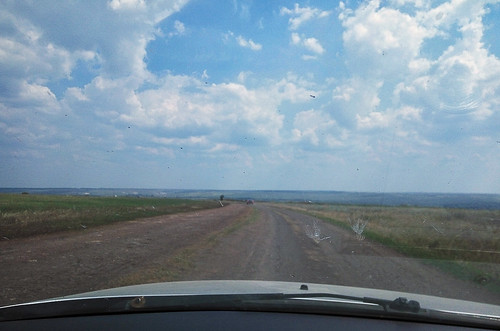
On the way back (Saturday), the navigator also circled part of the traffic jam, there weren’t many cars and they stopped for no more than half an hour, and there were many kilometers of traffic jams in three places for the meeting.
In Krasnodar there may be traffic jams on the bypass road.
When I returned, I read about the traffic police post in Kushchevskaya, how they like to check cars there. We passed it in both directions without problems.
Accommodation.
In Gelendzhik, the Hermes car camping cost 2,300 rubles for two nights: three people in one tent and car parking. Liked. Many trees create shade, the area is fenced, the beach is about 100 meters away and those along the embankment, there is a toilet and shower with centralized sewerage, hot water from 17 to 23 hours, there is a washing machine, there is a barbecue area, phone charging is paid separately 50 rubles at a time and a refrigerator 100 rubles per day, soil with stones.

In Anapa, Nizhneye Dzhemete district, the Blue Spruce campsite cost 800 rubles per day (2400 for three nights): a small tent plus a car. Payment depends on the size of the tent. The area is fenced, there is a lot of shade, there are sunny glades for those who like to steam in a tent, a toilet and shower with centralized sewerage, hot water from a boiler around the clock, charging is free, there is no refrigerator, but they can freeze briquettes for a thermobox. There is its own dining room, the menu hangs at the entrance, it costs about 200-250 rubles per person per time, you must inform in advance what you will be eating. We didn’t go there. The beach is a 5 minute walk. Near the beach there is a small shop, cafes and eateries. Large shops, market and entertainment a couple of kilometers away. In the evening there is a little noise from the neighboring holiday house, where entertainment programs are on until 23:00.

In Kuchugury, the navigator was supposed to take us to the “Azov Coast” camping site on Primorsky Lane, but, as I have now found out, they have moved. I didn’t know about it then. Now there is a sign “private territory” at the entrance. The cost depends on age, children are cheaper. It cost us 450 rubles/day (900 for two nights). The sea is about 30 meters away, there are many low trees providing shade. You have to be prepared, since the campsite is completely wild: the shower is a barrel, the toilet is a pit. The store is 700 meters away, it’s convenient to walk along the beach. Despite such amenities, the children really liked the sea and the beach.
We clear the place for the tent from cherry plums.
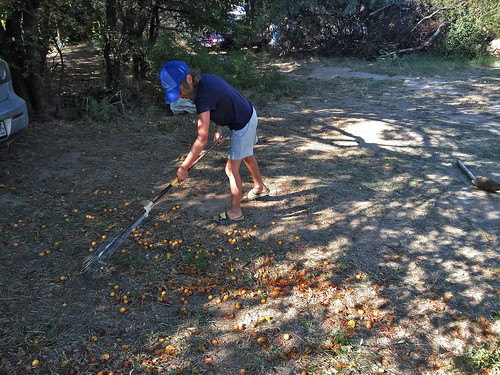
We canceled two campsites because we changed the route and the opportunity arose to stay with friends. As a result, over 7 nights we saved about 5,000 rubles.
Meals: one adult and two children.
It all depends on appetite. The main plan was to cook food on our own, for which we took a gas burner. In the absence of a refrigerator, I had to cook for one time. The children ate cereal with milk for breakfast. I bought milk in 200 ml Tetra Pak bags, which lasted the entire trip without any problems. Eight times we ate in canteens for about 600 rubles for three.
Entertainment.
There’s no limit. The main costs fell on Gelendzhik. There were many attractions near the campsite, plus the promised water park.
Impressions!
Day 1-2: Krasnodar
We left Moscow on Saturday, August 4 at 4 am and in 19 hours, with stops and traffic jams, we drove to Krasnodar (1370 km), where we stayed for two nights with friends.
We walked around the city. As a tourist, I remember Krasnaya Street, which is closed for festivities on weekends, a dancing fountain and a courtyard, somewhere in the late 19th century, with a cast-iron staircase. And, no police! Only near the administration I saw one car on duty, and occasionally Cossacks.

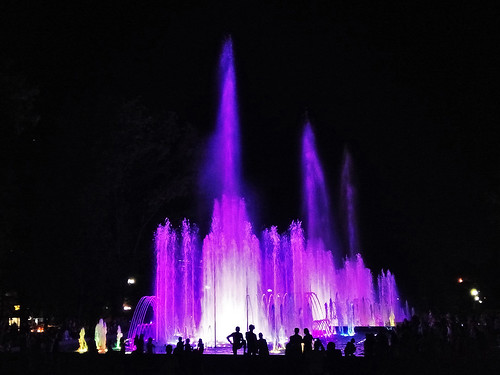

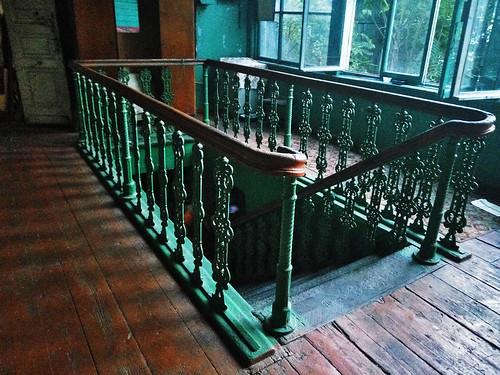
As a motorist, there are stupid traffic lights with arrows drawn forward and to the right on green, and when you turn right, you run into pedestrians crossing onto your green lane. Idiocy that you quickly get used to. If it’s “difficult” to make traffic lights with an additional section for turning right (fortunately, 4-lane roads allow it), why can’t the traffic be dispersed by turning on green for pedestrians throughout the entire intersection?
Day 3-4: Pshada
On Monday morning we left Krasnodar for Pshada, about 150 km, where we planned to stay for two nights. There were traffic jams on the bypass road in Krasnodar, then we drove quite freely to Dzhugba.
We stopped at Goryachy Klyuch to drink mineral water, stopped at the observation deck of the pass and went to Arkhipo-Osipovka to swim in the Black Sea. In Arkhipka, I didn’t bother looking for where to park, I parked in a paid parking lot next to the beach for 50 rubles/hour, a couple of hours would be enough to swim. There is an inexpensive canteen on the beach, lunch for three: three main courses and compote, cost 600 rubles.
In Pshad we stayed with friends for free for two nights. The village is located 15 km from the sea, but is popular among tourists: dolmens, waterfalls, off-road rides across the river for more splashes.
During the day we went to the sea to Krinitsa (there is a car camping there for those who wish), and in the evening we swam in the mountain river Pshada. We went to the dolmens, fortunately it’s only 1.5 km from the house. In Krinitsa the beach is pebbly. In the morning and late afternoon it can be difficult to park.
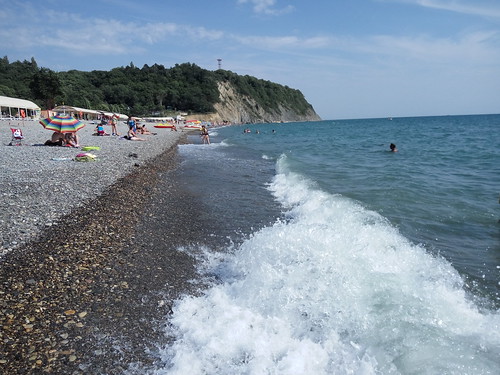

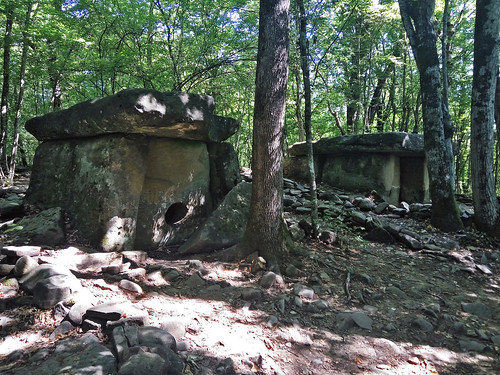
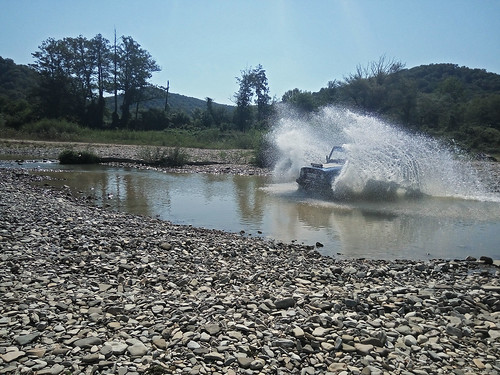
Day 5-6: Gelendzhik
In the morning we left for Gelendzhik where we planned to spend the next two days. On the way, we stopped in Sosnovka to look at the rocky shores, swim and at the same time see the camping site. If you come just for a day, you still have to pay an entry fee of 50 rubles/hour, and you won’t be able to park your car at the campsite. The road to the campsite is dirt and rocky. Camping is inexpensive: car 250 rubles/day, staying on the territory 100 rubles/day. The place is beautiful, but I decided that it would not be comfortable with children. You can only stay at the top and go down from the mountain to the beach along a path and stairs. The beach is narrow, pebble and deepens close to the shore.
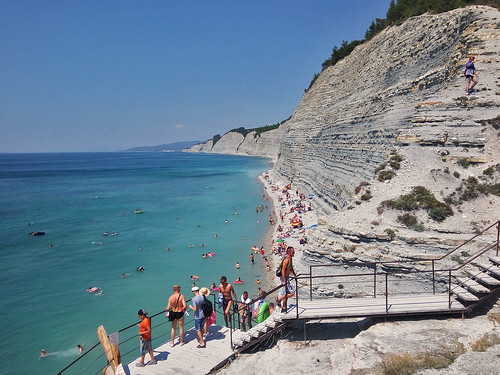
We stayed in Gelendzhik at the Hermes camping site, for two nights it cost 2,300 rubles.
In Gelendzhik, not far from the campsite on the embankment, there is an inexpensive, decent USSR canteen; lunch or dinner for three cost about 600 rubles, you can get into rush hour and stand in line.
The weather began to deteriorate, it was raining in the mountains, but the sun was shining on the coast. A strong cool wind blew from the mountains, so much so that an ice cream stall overturned, a tree broke, a plastic bucket rolled along the embankment and knocked people down. It got colder for the next few days.


We climbed the cable car of the Olympus Park to the mountain. The ticket price, for an adult 800 rubles, for children 400 rubles, includes a Ferris wheel on the mountain, there is also some kind of swinging attraction, a petting zoo and a terrarium. Children are not allowed to ride the cable car unless accompanied by an adult. Since I was with two children, I had to wait until there was a free seat in a seat with an adult in order to send one of them with him.
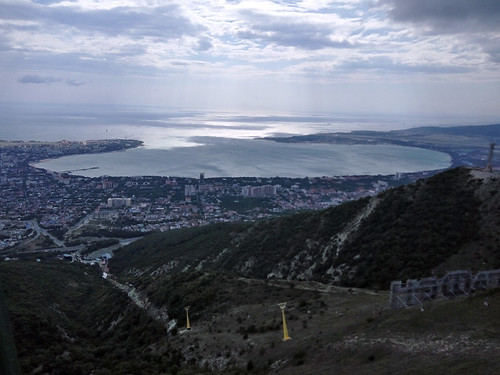
Water park “Behemoth”. I am indifferent to water parks, so basically: a ticket for a half-day from 14 to 19 hours costs 1200 rubles for adults and 650 rubles for children. Children from 140 cm already have an adult ticket and can use part of the large slides. You cannot bring water with you; security takes it and returns it at the exit. There is a cafe on site. Near the complex there is parking for visitors for 50 rubles/day. The children enjoyed it despite the cold weather and wind.
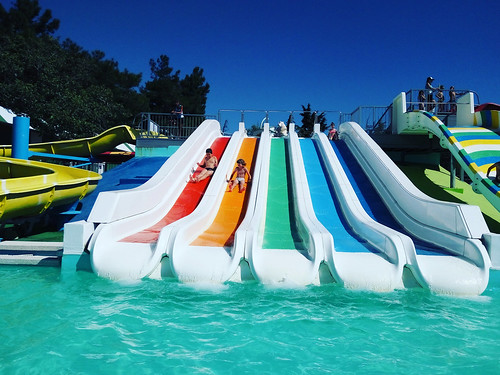
About a ticket to a water park and the desire to learn to swim.
At sea, children swam in oversleeves and flatly refused to study. But, thanks to the fact that one child had to buy an adult ticket at the water park, but he could not go to the big slide, since he had to dive there, he immediately had a desire to learn. Both returned from the sea swimming like dogs.

Day 7-9: Anapa
In the morning we left for Anapa. There is a traffic jam in Novorossiysk in both directions due to road reconstruction, here the navigator again offers detour routes in neighboring blocks.
In Anapa, Nizhneye Dzhemete district, the Blue Spruce camping site cost 800 rubles per day. Stayed for three nights. There are two canteens near the beach, where for three it cost about 600 rubles. It’s a 5 minute walk to the beach, the sea is shallow and in bloom. The beach is sandy with a ridge of beautiful dunes.

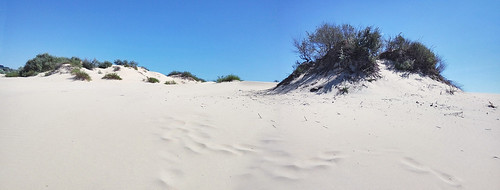

Day 8: Crimea. Day of Two Seas
We decided to take a ride around the Taman Peninsula. First we went to Veselovskoye to look at the salt lake and sand spit between the Black Sea and the Kiziltash estuary. There is a car camp here. There are plenty of places where you can park your car before the campsite.
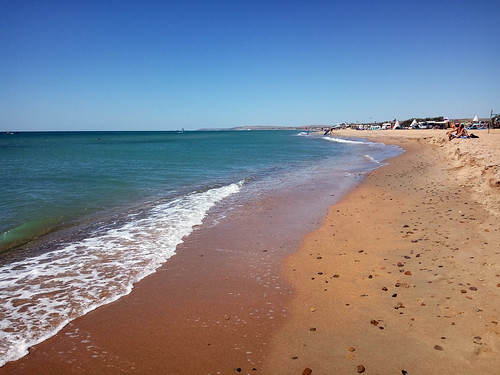
The lake bottom is better than the asphalt on some roads. People are having mud baths
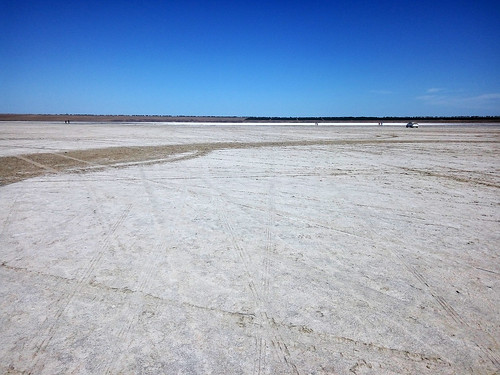

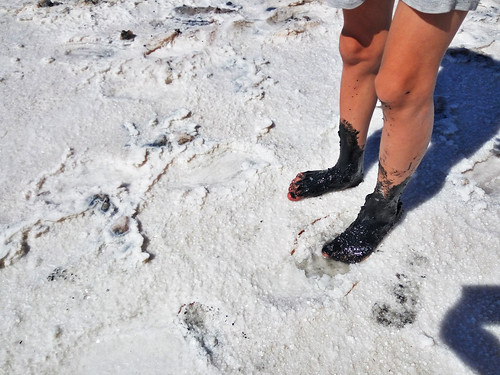
kiting is popular on the estuary

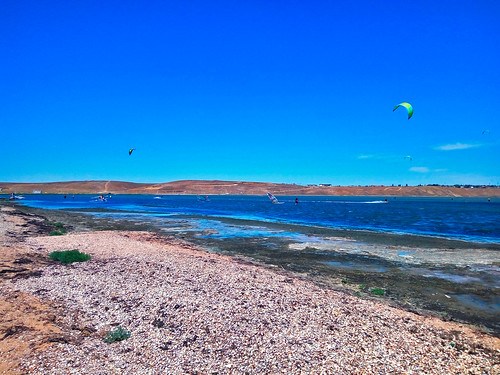
The children asked to drive across the Crimean Bridge. Part of the A-290 road has been reconstructed, the asphalt is good, trucks are not allowed on it yet, there are not many cars.
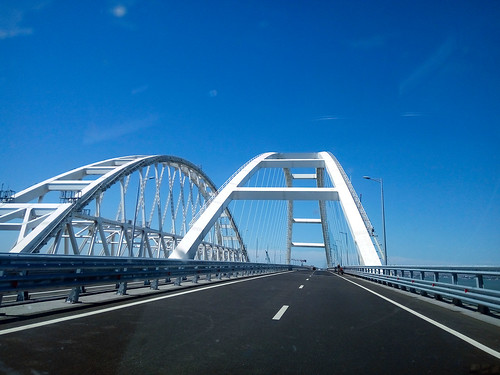
Visit Crimea and not take a swim? I looked in advance at what places there were near Kerch and I liked General’s Beach in the village of Kurortnoye on the shore of the Azov Sea. The road to the village is dirt, you can’t speed up. The place is beautiful: a cape, a beach sandwiched by rocks and with high waves. We swam nearby in the village; the sea was shallow, but not in bloom.
In the evening we returned to Anapa.
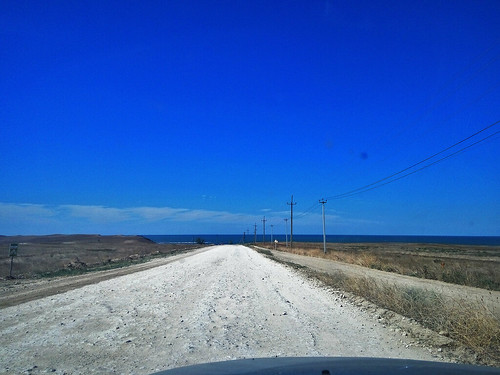
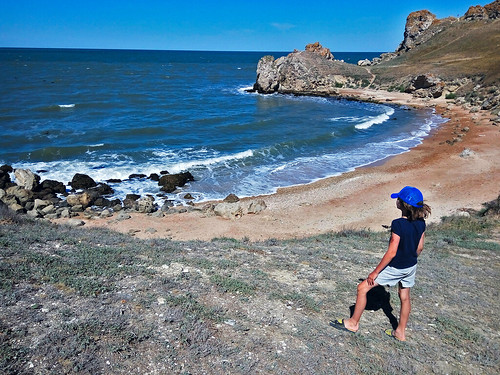
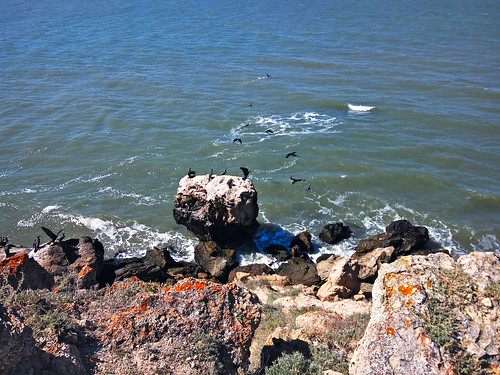
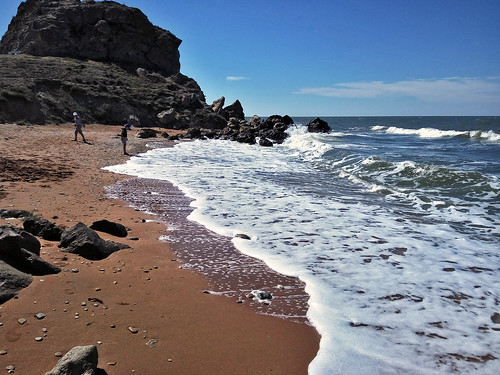
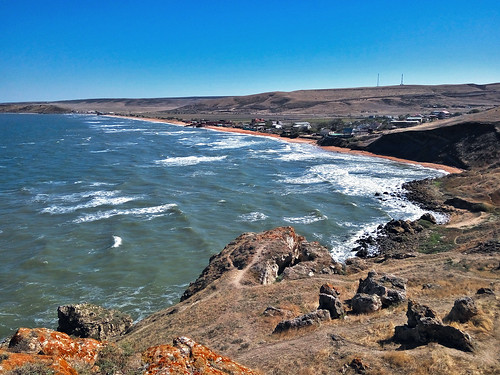
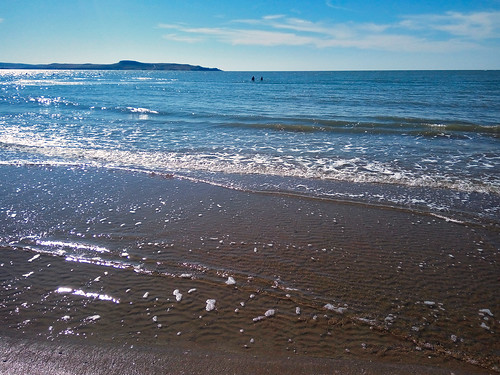
Day 10-11: Kuchugury, Sea of Azov
In the morning we drove towards Kuchugur on the Sea of Azov. First we stopped in Taman to see the exhibition complex Cossack village “Ataman”. The cost of a ticket for the whole day on weekdays is 300 rubles for adults, 150 rubles for children over 7 years old (on weekends 400 and 200), there is ample free parking nearby. It’s better not to come on Monday, as many farmsteads are closed. The complex is interesting, you can spend the whole day there.
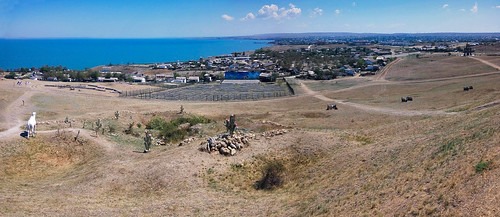
Then we went to see the mud volcano Akhtanizovsky Sopka, it is the highest on the peninsula and essentially inactive. In some places, traces of freshly spilled dirt are visible on the sides. From here there is a wonderful view of the surrounding area, the village of Akhtanizovskaya and the estuary of the same name.
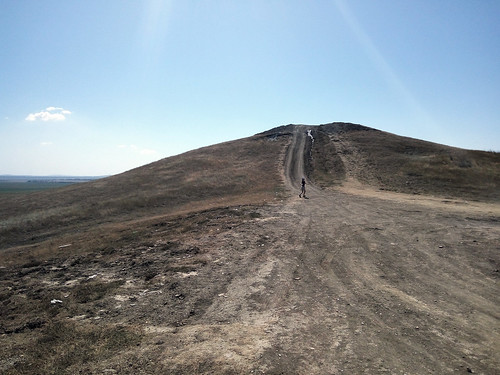
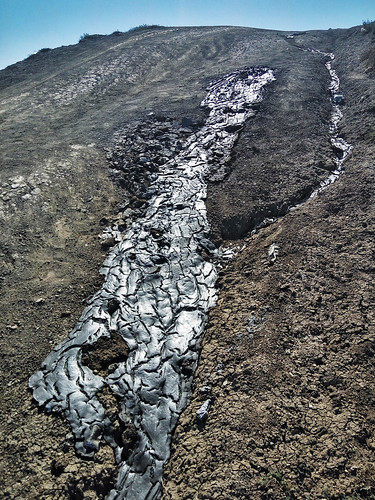
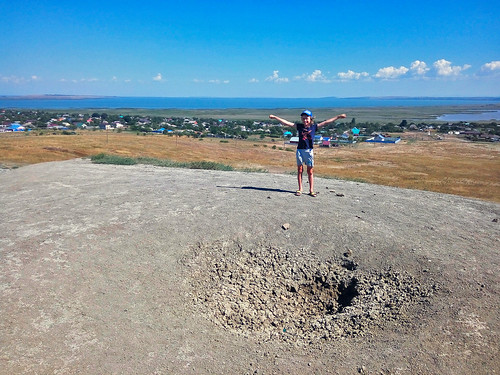

In the evening we arrived in Kuchugury. The beach is good, sandy, the bottom is varied, in some places it’s shallow, in others it’s just right for children. But, with rough seas, it can change literally overnight. We have ridges in the form of waves at the bottom, you walk up to your waist, rise up to your knees, then again up to your waist/knees. You stand on such a crest and when the wave passes, a strong reverse current comes from the shore, knocking you off your feet, a very funny sensation.
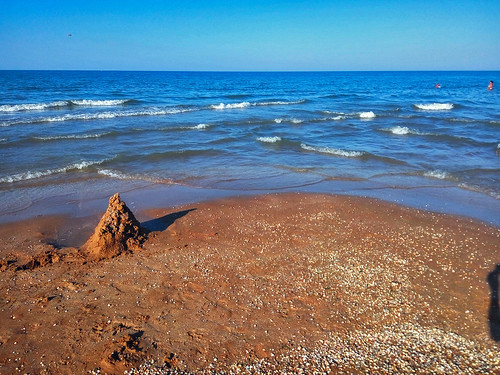
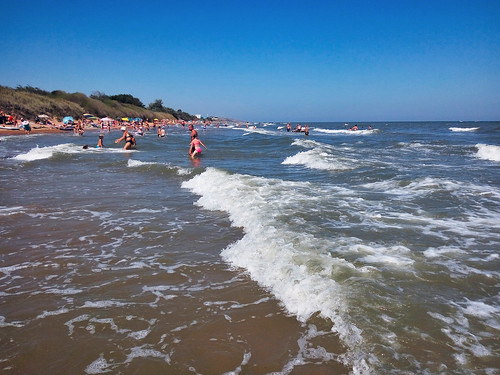
Three kilometers from the village on the shore of the Azov Sea there is an active mud volcano Plevak. A dirt road leads to it along a picturesque steep bank. I got myself dirty, hobbled to the beach and swam.
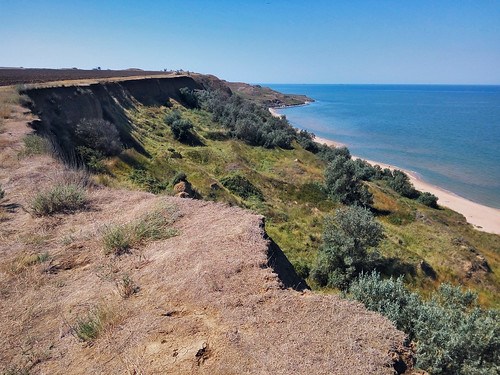
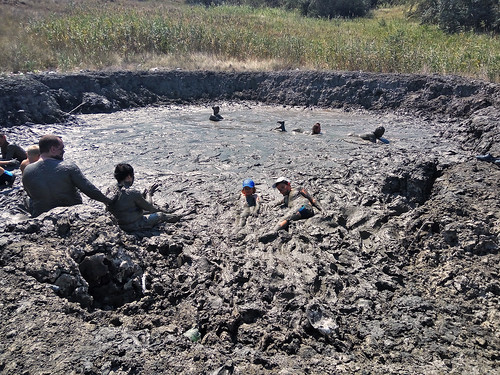
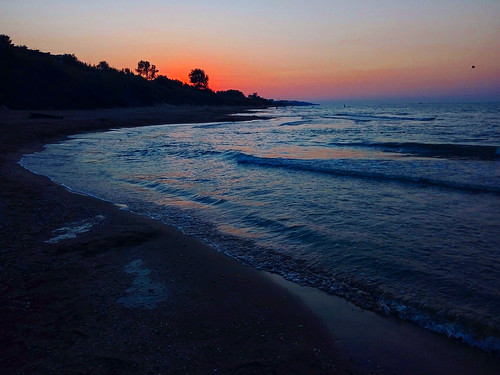
Day 12-14: Pshada
At lunchtime we went back to Pshada, as a classmate was visiting whom we had not seen for a long time. Thus, we changed the original plan and did not go to the campsite in Durso.
We stopped in Novorossiysk at the observation deck
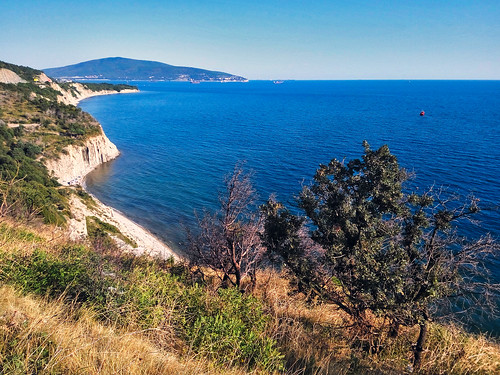
It’s also good in Pshad, the main thing for children is the sea, although it’s 15 km away in Krinitsa, a mountain river two minutes from the house.
Game of pebbles. Bones from improvised means.
– You lost a pebble!
– Are there not enough stones on the beach for you?
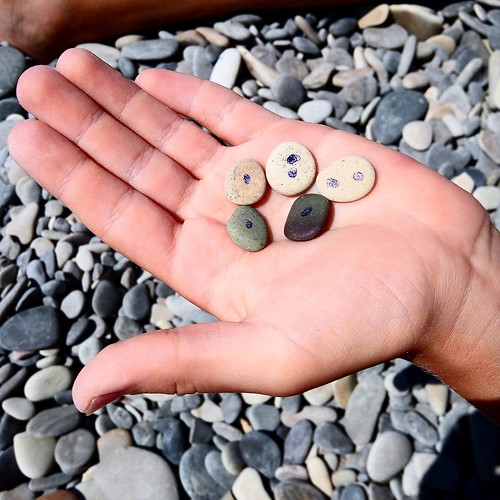
Day 15: Moscow
We left on Saturday, August 18 at 3 a.m., with 1,500 km ahead. On the way we saw sunrise and sunset. We arrived faster than at sea – in 17.5 hours, despite the fact that we had to leave the highway and look for a gas station in the Lipetsk region. Their butts got used to the seat, the children got used to the road, and stopped less often. The navigator circled part of the traffic jam in the Voronezh region; we stood for no more than half an hour, but there were oncoming traffic in three places with many kilometers of traffic jams.
Did I get a break from caring for two kids? In general, yes. For me, the main thing is to change the environment and not sit in one place.
Road dust
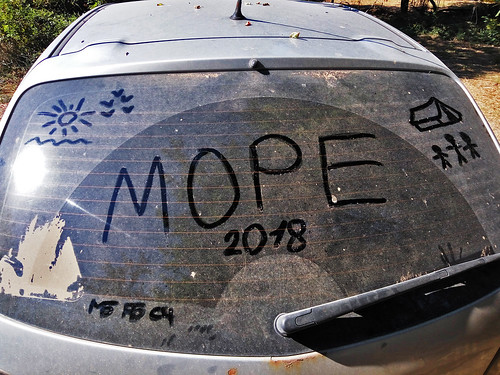
How to make paper at home
You will need:
Large saucepan
Sheets of used paper
Mixer or food processor
Water
A piece of gauze with fine holes
Soluble starch (two teaspoons)
Two sheets of blotting paper (or newspaper)
What to do:
Tear the paper into small pieces (no larger than 2×2 cm) and place them in the pan. (If you are using a food processor, simply put the torn paper in it, add a little water and pulse until the paper breaks down into fibers. Then pour the resulting mixture into a pan of water and proceed to step 4)
Pour water (preferably warm) into a saucepan. If you want to use starch, add it to the water now (two teaspoons).
Let the paper stand for 10 minutes, and then beat with a mixer until the paper fibers separate and the mass becomes soft.
Gradually lower a piece of gauze into the pan with one edge, holding it by the other edge. Immerse it completely in the mixture and then carefully remove it.
Let the water drain back into the pan
Cover the gauze with blotting paper and turn it over, but be careful so that the resulting “cellulose” does not disintegrate.
Carefully remove the cheesecloth and cover the remaining “pulp” with a second sheet of blotting paper and roll.
Dry with an iron
Carefully remove the blotting paper. Do not touch the resulting sheet for 24 hours until completely dry.
METHOD II
You will need:
Mortar and pestle
Liter glass beaker
Burner
Pan
A piece of gauze with fine holes
Waste Paper
Two sheets of blotting paper (or newspaper)
What to do:
Tear the paper into small pieces (no larger than 2×2 cm) and place them in a beaker.
Add a little water to cover the paper. Place the beaker over the burner and heat for 10 minutes.
Pour the resulting mixture into a mortar and crush well with a pestle.
Add this mixture to a pan of water.
Now go to step 4 of METHOD I.
G. Carboni, January 2005
Translated by Jennifer Spears
Paper is a fantastic material suitable for numerous uses, including manufacturing notebooks, books, calendars, and magazines, wrapping gifts, and wrapping items in stores. Paper is widely used in offices for writing, printing documents, and photocopying. At home, paper is used to clean, to dry things, and for many other purposes. In short, paper is one of the most versatile and common products of modern societies. In this article, I will describe how to make samples of paper and I will outline the theme of recycling raw materials.
Paper is so essential to writing that we couldn’t do without it, and yet it was not invented until several millennia after the invention of writing. So, what did people write on before the invention of paper? Some dozens of thousands of years ago, primitive humans started to draw graffiti and paint hunting scenes on rocks and cave walls. They also carved notches on sticks, shells, bones, and stones. It seems they used these signs to count things like days, lunar months, and the animals they bred. From these first paintings and carvings begins the path that will lead to writing, but also the history of the materials used for writing begins here. It is of these items that I will speak in this section.
CLAY TABLETS
Writing was invented about 5500 years ago by Sumerians, a people devoted to agriculture who lived in ancient Mesopotamia. As a medium for their texts, Sumerians used clay tablets. Clay is basically mud and in their alluvial plains they had plenty of it. With clay, they prepared tablets in which they etched pictures or symbols as long as the tablets were still damp and soft enough. These tablets were then left to dry so that the signs engraved could be kept for a long time. First Sumerians, then Babylonians and Assyrians used these tablets primarily for administrative purposes and notating agricultural products delivered to warehouses near temples. Tablets were often stored on wooden shelves. The only possible danger would have been water which could ruin the tablets. Conversely, if a fire were to break out, the clay tablets would undergo a cooking that would transform them into terracotta, a material impervious to water and able to last thousands of years. Fires which because of accidents or war sometimes struck the archives of these ancient people allowed thousands of cuneiform tablets to be preserved till modern times. Their deciphering by archaeologists is giving us important information on the ancient civilizations which produced them.
PAPYRUS
Shortly after the Sumerians, ancient Egyptians developed their own writing. They took some of their symbols from the Sumerians, but also invented many other symbols, comprising an original script of their own. Egyptian writing was widely used for sacred and celebratory purposes; for this it came to be called hieroglyphic (‘sacred writing’). Egyptians sculpted or painted their writings on stony temple walls and wooden sarcophagi. One of the most important inventions of the Egyptians was the papyrus, a medium which begins to have some likeness to paper. Papyrus takes its name from the plant from which it was obtained. This plant has its roots in water and develops a long cylindrical stem which ends with a tuft of narrow and long leaves. From the spongy stem of this plant, Egyptians extracted thin strips that they placed side by side, partly overlapping them. Subsequently, over the first layer of strips, they superimpose a second layer, placing the strips transverse to those below. The natural glues present in this plant’s tissue insured the adhesion of the strips. Other sheets were often adjoined to the first sheet, rendering strips that could even be several meters long and that came to be rolled up in volumes
. To improve the possibility of using this surface for writing, Egyptians beat, scraped, and smoothed papyri during their production. Egyptian scribes wrote on papyrus using brushes and ink.
http://www.museolibroantico.com/corso_libro_antico.html
Pictures of the fabrication of papyrus.
PARCHMENT
Ancient Egyptians produced a lot of papyrus, part of which was retained for their own use and the rest to be sold in all of the Mediterranean. Among their best customers were the ancient Greeks and Romans. Unfortunately, because of political and economic crises which struck Egyptian society in the last centuries before Christ, the production of papyrus diminished. The price of the product increased and it became necessary to find a substitute. In the city of Pergamus, people started using sheepskin as a medium for writing. From just one skin, one could get several sheets as it was possible to separate more layers from the skin. To make them suitable for writing, the skin had to be adequately prepared. Towards that goal, sheets were scraped to remove fat and flesh, then put out to dry on frames which kept them tight. The final product was parchment, a material highly suitable for writing which came to be used in Europe throughout the Middle Ages, up until the introduction of paper. An old parchment could be scraped of the previous writing and could therefore be reused. In this manner, however, many works by Greek and Roman authors have been lost.
PAPER
According to the Chinese, paper was invented in 105 A. D. by an official of the Emperor, but recent archaeological findings have shown that paper was already being used in China at least 200 years before this. The Chinese used large quantities of paper made from rags and vegetable fibers extracted from hemp, bamboo, mulberry, willow, etc. They also used paper to make fans, hats, clothes, and other everyday objects. Paper was brought and spread to many Eastern countries by Buddhist monks.
In 751 A. D., after a thirty-one-year war, Arabs defeated the Chinese in battle. Among the prisoners taken were paper factory workers who taught the technique of papermaking to the Arabs. Soon thereafter, Samarkand became an important center of paper production. As raw materials, the Arabs used linen and hemp rags. A few centuries later, the art of papermaking came to Egypt, then Morocco, and from there Spain. The first Spanish paper factory was opened in 1009.
In 1250, Italy became the biggest producer of paper, which came to be exported to many European countries. To make paper less absorbent, Arabs used glues derived from vegetables, but this type of paper was susceptible to mold and quickly deteriorated. By using glues derived from animals, Italians greatly improved the quality of paper and its duration could reach many centuries. In fact, today we know of paper documents which are still in very good condition after more than 700 years from their production. An important Italian papermaking center was Fabriano, where the watermark was invented. Within about three centuries, the technique of papermaking spread from Italy to all of Europe and then to the Americas.
In the beginning, Arabs and Europeans made paper out of rags. As time passed, the demand for paper quickly increased, so much so that after a while, rags were no longer sufficient. In search of a substitute to rags, in 1719 a Frenchman, who had observed wasps while building their nests, suggested
trying wood to make paper. The trials that were carried out were a success and since then wood has become the main raw material for producing paper.
To separate individual fibers of cellulose from each other, rags and wood were placed in mortars and beaten by heavy pestles operated by hydraulic wheels. When the mixture of fibers was ready, workers poured it into vats full of water. They then immersed special sieves into the vats and extracted them collecting a part of the suspension of fibers. During the extraction, workers moved the sieve in order to make the layer of fibers uniform. Then they let the water drain out, and they placed the layer of fibers on a piece of felt which was placed on a pile of other sheets and bits of felt. This pile was pressed to squeeze away the water. Finally, the sheet of paper was hung to dry.
In the beginning of 1800, the French and the English began to build machines for the perpetual production of paper. Paper machines were equipped with a long sieve in the form of a moving belt which collected a continuous layer of fibers from the suspension. During its run, the ribbon of paper under formation has glue, mineral additives, and other substances added to it; then it is squeezed of excess water, dried, and rolled. Finally, it is gathered in large rolls and sent to factories which turn it into newspapers, notebooks, and many other products. The fabrication of paper by hand is still practiced to produce precious sheets or for artistic purposes, but this represents a very small quantity of the paper produced in the world.
Modern paper is therefore produced primarily from wood and it is made up of numerous cellulose fibers that are held together by glue. Paper can undergo special treatment in order to make it suitable for whatever intended use. Take for example the paper used for drawing and watercolors, which must have a specific thickness, a certain roughness and a certain absorbency, etc. It is also possible to make paper without adding glue, but the result is a very absorbent paper. To render it suitable for writing or printing, it is necessary to lower the absorption of ink which otherwise would spread. For this purpose, paper is glued, that is, animal or synthetic glues are added to it. To make paper less porous, more compact and even brighter, it is coated
. Coating consists of adding very fine mineral powders such as kaolin, calcium carbonate, talc, fossil flour, and an appropriate adhesive such as casein or other types of glue. The sheet passes through rollers which press it with force (calandering) and comes out bright.
Often people use tissues or paper napkins to clean the lenses of glasses or cameras, but the presence of mineral powders make ordinary paper products unfit for this purpose. In fact, when rubbing on delicate optical surfaces, these mineral particles cause microscopic streaks which ruin the quality of the lens. To clean lenses, you can use special paper products specifically produced for that function, composed solely of pure cellulose.
Unfortunately, certain modern papermaking processes greatly reduce the life of paper, which within a few years tends to yellow and weaken. Processes exist which instead produce paper capable of lasting centuries, keeping itself in very good condition.
The importance of the invention of paper can be better understood if people think that before its arrival, to make a book in parchment, dozens or hundreds of skins were needed. Because of its uniformity in thickness, paper made possible the invention of the printing press. Before the invention of the printing press, books had to be written by hand. Together, these two innovations greatly lowered the cost of books and largely contributed to the spread of culture throughout the world.
Let’s pass to the experiment part of this article. By now, you understand that to make a sheet of paper, you must first get a suspension of cellulose fibers in water. Getting these fibers from a trunk is possible, but it would take too much time and effort. Therefore, we will use newspapers, from which it is easier to extract fibers. In this manner, we will also experiment with the possibility of recycling paper.
With wooden boards, make a frame like that of figure 3. Mount the sieve underneath, with strips of wood and nails enclosing it (figure 4).
PROCEDURE:
– soak some of the newspaper in water (it’s better if you let it to set for a day or two);
– squeeze out the excess water;
– with the mortar and pestle, crush a little bit of paper at a time until you get a homogeneous paste, consisting of fibers isolated from each other (figure 5);
– repeat this until you have enough paste;
– fill the bowl halfway with water;
– put the paper paste in the bowl and stir it to separate the fibers;
– remove any resulting clumps (a dense suspension of fibers must remain in the water);
– immerse the frame in the watery suspension in the bowl (the sieve should be facing the bottom of the bowl);
– slowly remove the frame from the suspension keeping it steadily horizontal; eventually move the frame to even out the layer of fibers (figure 6);
– wait for the water to drain;
– place the smooth side of a sheet of Formica on top of the sheet of paper still soaked with water;
– press on the Formica a little to drain the water, taking care not to deform the sieve (figure 7);
– with a sponge, collect water from underneath and squeeze it away every so often;
– carefully remove the sheet of Formica so that the sheet of paper remains attached to it (figure 8);
– let the sheet of paper dry. To do this more quickly, you can dry it with a hairdryer (figure 9).
– make other sheets of paper, introducing to the suspension some grass crushed in the mortar;
– (optionally) later introduce some flower petals (without crushing them).
The presence of green and brown vegetable fibers from the grass will give your sheets a special charm. Also, the addition of petals will contribute to make the sheets more beautiful. You can even use the paper you will have made to write a letter.
The paper you make using this procedure (figure 10) will be bright on one side and opaque on the other. The bright side is more suitable for writing. This paper is highly permeable by ink, but it is possible to write on it using a ballpoint pen. If you want to reduce the absorbency of the paper you’ve made, soak it in a solution of water and gelatin and then let it dry again.
As you have seen, paper is made up of cellulose fibers held together by glue. By hand or even by means of special machines, it is possible to separate the fibers of paper from each other and reuse them to make new paper. In the industrial processes of recycling printed paper, a deinking treatment is often performed in order to brighten it.
What does recycling paper mean? As you know, to produce paper it is necessary to cut down trees. Considering the large quantity of paper used in the world (about 300 million tons), every year entire forests are cut down. This constitutes disruption to nature. Moreover, when paper is no longer needed,
it is often dumped in landfills, but part of it also ends up in the environment, contributing to pollution. Recycling paper means reducing both the number of trees cut down and pollution to the environment (figure 11).
Why do we use the term recycling? Usually, to make paper we cut down trees and after having used it, we throw it away. As figure 11 shows, this corresponds to a linear movement from forest to landfill. If instead we also use already used paper to make new paper, rather than going to landfills, paper returns to the market. Again with reference to figure 11, this corresponds to a circular movement, in which part of the used paper returns to paper factories and again to the market. This circular movement can be repeated several times and can be applied to other materials, garnering the important advantage of notably reducing the damage to nature caused by our activities.
Other than paper, is it possible to recycle other materials? Absolutely! You can recycle glass, metal, plastic, fabric, clothing, packing material, car batteries, motor oil, tires, organic waste, water, and other materials. Though not intended for recycling but for controlled disposal, pharmaceuticals, batteries, paint, plaster and other waste which, if left in the environment, would cause pollution are also collected.
RECYCLING GLASS
Glass is produced by melting sand at high temperatures. In turn, glass items can be melted again and transformed into new products. Bottles and jars brought to temperatures between 800 and 1500°C soften and then melt. At this point, the material is homogenized by stirring, is refined, and is often bleached. It can then be used to make new glass items. The recycling of glass is very beneficial in terms of energy conservation.
In addition to recycling, we also need to consider reusing products. Some types of bottles and other glass containers can be washed and reused dozens of times. The system of depositing bottles is highly respectful to the environment. In fact, reusing items is more efficient energy-wise than recycling them. Knowing how to use products without ruining them means prolonging their life and reducing the need to buy new ones.
RECYCLING METAL
Metal is produced by bringing certain minerals to high temperatures and adding melting materials, deoxidizing materials, etc. To be recycled, metal must be collected and separated by type: steel, cast iron, copper alloys, aluminum alloys.
Aluminum alloys melt around 550-650°C according to the alloy. Since the normal production of aluminum from bauxite requires large quantities of electrical energy, the recovery of this metal is particularly important.
Copper is widely used in making electrical wires. Copper alloys are widely used in factories. The main copper alloys are bronze (copper tin) and brass (copper zinc). Copper melts at 1083°C, bronze between 900 e 1000 °C, and brass at about 900°C. The world reserves of copper are becoming exhausted, making the recycling of this material important.
In metallurgy, one distinguishes iron (chemical element) from steel, which is an alloy derived from iron and other elements. Cast iron has a higher carbon content than steel. When burnt in furnaces for the production of steel, carbon frees large quantities of carbon dioxide, carbon monoxide, sulfur dioxide, and pollutes the atmosphere. Steel melts at about 1500°C, is inexpensive, and is not particularly rare, but the collection and reuse of scrap iron is nonetheless useful because it reduces the need for extracting iron ore and the amount of carbon necessary to produce new steel. Because of the presence of nickel in their alloy, austenitic stainless steel is expensive and recycling it is important.
RECYCLING PLASTIC
Plastic is derived from oil and is rather costly as well as its producing processes often being polluting. Many plastics break down very slowly and when they end up in the environment, they pollute it for a long time. Many dolphins and whales die because of plastic bags carried to sea by the wind that they end up swallowing. Recycling plastic is therefore important for economical reasons, energy conservation, and for reducing pollution to the environment. On the market, there are many different kinds of plastic such as polyethylene, PVC, polystyrene, polypropylene, etc. In order to recycle them efficiently, they could be separated by polymer type. Unfortunately, this is difficult to do, and for the time being we are limited to a unsorted collection of only a few types of plastic.
All plastics can be recycled by the process of pyrolysis. Pyrolysis consists of bringing plastic to a temperature of 500°C in the absence of oxygen. At this temperature, plastic decomposes producing gases which can be used to make new plastic or can be burned for the purpose of creating electrical energy.
RECYCLING ORGANIC MATERIAL
Food scraps, cut grass, small pruned branches, fallen leaves, etc. are easily decomposed by bacteria, earthworms, and other little organisms. At the end of this process, we are left with a very fertile soil, called compost
, for use in agriculture. To facilitate their transformation into compost, organic waste is gathered in the appropriate containers (composters) where they undergo the biological transformation described above. The recovery of organic waste is important because it is rather voluminous and becomes rather costly for normal disposal. Moreover, if thrown into dumpsters, the food scraps would dirty any other recyclable items in the garbage making those items less easily separable and collectible. Returning organic substances to farmlands or even your own backyard through composting renders the soil more fertile and reduces the need for chemical fertilizers.
RECYCLING WATER
Water from the sewage system and from agricultural drains can be purified and reused. One of the processes of purification consists of making water flow into lakes or special purifying plants, where the organic substances present in it are used as food by bacteria and other microorganisms. At the end of the process, these substances are transformed into mud which sediments at the bottom. Passes across sand and other procedures complete the purification of water, which can again be made drinkable. Often, the resulting mud can be used in farming as fertilizer. Also most of the runoff water from industrial processes can be purified.
Recycling raw materials is important for reducing the damaging alterations to the environment produced by human activities. By recycling raw materials, we collect a smaller amount of raw material from nature and also reduce the amount of waste. Important steps in recycling raw materials include sorting them at home and in the office and a sorted garbage collection. Through sorted garbage collection, those materials which before were just throwaways that went towards polluting the environment have become more and more of an economic resource. Nowadays, an industry for the recycling of raw materials is on the rise. Companies which specialize in the online advertisement and sale of industrial waste which can be useful to other companies have also been born.
The analysis of the life cycle of products, or Life Cycle Assessment
or Life Cycle Analysis
(LCA), is an evaluation of the influence of products on the environment (environmental impact), calculated from their creation to their disposal. Studying the life cycle of a product means analyzing the materials used to produce it, the method of extracting the raw materials, the production process employed, how it is marketed, how and for how long it is used, and how it is disposed of. Life cycle analysis is calculated with reference to the environment, considering how the environment is altered at each stage of the product’s life. From this analysis, we can arrive at valuable directions on reducing the collection of raw materials from the environment and subsequently better recycling them. This analysis can also suggest which materials to use and which processes of extraction, manufacture, use, and disposal are most sustainable with respect to the environment (eco design). The object of LCA can also be activities and services, for example sanitation services, postal services, and obviously many other activities which do not yield tangible products but offer equally important social benefits.
In the course of this article, you have seen how paper is made and how it is possible to produce beautiful sheets of paper at home with little expense and limited equipment. Making paper with your own hands is without a doubt an interesting activity. It is also fascinating to know that the paper we use so nonchalantly is the fruit of a long journey, begun thousands of years ago when our ancestors took to drawing graffiti and paintings on rocks. From rocks, we passed to clay tablets, then papyrus, parchment, and only at the end, to paper. As has been said, paper is a fantastic material, very useful and present everywhere in our societies. The recent arrival of computers seems to put into question the existence of paper, which, according to some, is destined to disappear.
By now, several years have passed since we entered the computer age. More and more we read documents on monitors rather than paper. We record documents on media such as disks, but the use of paper has not abandoned and perhaps it hasn’t even diminished. Paper continues to be a part of our lives and many of us still prefer to read books on paper instead of on a screen. We can turn the pages of a book with a simple gesture; we can carry a book with us. Reading a book on a monitor is not as comfortable and our eyes tire quickly. Moreover, reading a book on a screen forces our bodies into an unnatural stationary position which after a while tires us.
Electronic devices dedicated to the reading of books, newspapers, and other documents on a flat screen are appearing. These devices allow you to read a page at the time and to move to the next page by pressing a key. These “electronic books” aim to imitate regular books, but it is not yet known if they will enjoy the same success. On the horizon, we foresee books, magazines, and newspapers made of electroluminescent plastic sheets which will receive the news from the Internet.
The computer medium on which people write or draw is intangible, or rather, it is made up of different kinds of disks; but on these disks we cannot see anything, and to read them, it is necessary to insert them into a suitable reader. The material on which are documents are saved is perishable. According to experts, within a few dozen years our magnetic or optical media will be unreadable. It’s a real shame for a technology as complex as ours to not even withstand comparison in terms of durability to cuneiform tablets which have retained their information for over 5000 years!
In this article, you have seen how recycling paper is possible and useful, and from there we moved on to discussing the recycling of other materials. You may have also realized how useful and important recycling is in reducing the collection of raw materials from nature and in minimizing environmental pollution. While scientists study new methods of recycling and many companies analyze the life of products in order to reduce their environmental impact, companies which turn waste into resource are booming. The world is constantly changing and I am convinced that paper will survive the computer era wonderfully, and most likely, paper will stay with us for a long time to come.
http://www.twinrocker.com/sbkstch2.htm
Papermaking Techniques
http://www.handpapermaking.org/ArticlesforBeginnersIndex.html
Articles on Hand Papermaking for Beginners
http://www.ipst.gatech.edu/amp/collection/index.htm
American Museum of Papermaking
http://www.eia.doe.gov/kids/energyfacts/saving/recycling/solidwaste/paperandglass.html
Recycling Paper and Glass
http://www.glassonline.com/infoserv/history.html
History of Glass
http://www.uneptie.org/pc/pc/tools/lca.htm
Life Cycle Assessment
http://artgraph.clisson.free.fr/html/papier.htm
La Fabrication du Papier (d’après les illustrations de l’Encyclopédie de Diderot et D’Alembert)
http://www.museolibroantico.com/museo.html
Museo didattico del libro antico, tecniche di arte libraria antica
Internet keywords:
papermaking, history paper, recycling paper, stock exchange waste recovery
Как сшивать документы нитками 3 отверстия: как правильно подшивать? – о бумаге .нет – о бумаге .нет
“Кадровик. Кадровое делопроизводство”, 2021, N 11
КАК ПРАВИЛЬНО СШИВАТЬ ДОКУМЕНТЫ
В статье рассказано о всех нюансах правил прошивки документов. Читатели ознакомятся с тем, как правильно пронумеровать, составить опись, передать в архив кадровые документы .
——————————–
Статья опубликована в журнале “Хороший секретарь”, N 8, 2021.
Казалось бы, нет проще занятия, чем сшивать документы. А между тем, не так редки случаи, когда документы, подготовленные для сдачи в архив, возвращаются. Перешить, перенумеровать, добавить опись… Этот, с одной стороны, легкий, а с другой стороны, немаловажный процесс требует особого усердия, внимания и знания некоторых правил документооборота. К сожалению, четких инструкций и нормативных актов по прошивке документов нет. Но есть общие собственные требования различных инстанций, к примеру, общие рекомендации по прошивке документов формата А4 можно почерпнуть из Методических рекомендаций по разработке инструкций по делопроизводству в федеральных органах исполнительной власти, утв. Приказом Росархива от 23.12.2009 N 76 и из ГОСТ Р 51141-98 “Делопроизводство и архивное дело”.
Чаще всего необходимость прошить документы возникает при отправке пакета документов на тендер и при архивной обработке дел. Общепринятые правила по прошивке документов обеих направленностей практически идентичны.
Нумерация листов
Нумерация листов в делах необходима для закрепления порядка расположения документов после прошивки (шнуровки) для обеспечения их сохранности. Необходимо пронумеровать все листы в деле, кроме описи. Надо запомнить, что нумеруются именно листы, а не страницы документа. Если это не тендерная документация, когда все необходимые для представления документы заявлены в определенном порядке, то подшиваться документы должны в хронологическом порядке. Или, если это обосновано здравым смыслом, по какой-либо другой понятной системе – в алфавитном порядке или в порядке поступления в организацию. Если в подшивке документов есть конверт с вложенными листами, то сначала нумеруют конверт, затем поочередно каждый вложенный лист. Чистые листы из дела изымаются (без повреждения целостности дела) и уничтожаются. Листы нумеруются простым карандашом сверху вниз в возрастающем порядке номеров, начиная с первого. Цифры проставляются в правом верхнем углу листа, не задевая текста документов. Листы внутренней описи нумеруются отдельно.
Листы дел, состоящих из нескольких томов или частей, нумеруются по каждому тому или части отдельно, начиная с 1-го. Приложения к делу, поступившие в переплете, оформляются как самостоятельные тома и также нумеруются отдельно.
Документы с собственной нумерацией листов, в том числе печатные издания, нумеруются в общем порядке или сохраняют собственную нумерацию, если она соответствует порядковому расположению листов в деле.
Фотографии, чертежи, диаграммы и другие иллюстративные и специфические документы, представляющие самостоятельный лист в деле, нумеруются на оборотной стороне в левом верхнем углу.
Сложенный лист большого формата (форматов А3, А2) разворачивается и нумеруется в правой части верхнего поля листа. При этом лист любого формата, подшитый за один край, нумеруется как один лист, а лист, сложенный и подшитый за середину, подлежит перешивке и нумеруется как один лист.
A sheet with firmly pasted documents (photos, clippings, extracts, etc.) is numbered as one sheet; At the bottom or on the back of such a sheet, an inventory of the documents pasted on it is made. In the internal inventory and in the certification at the end of the case, a reservation is made about such sheets. For example: “On sheet 6 there are 5 photographs pasted according to the description on the back of the sheet.”
Maps and diagrams glued together from several sheets are numbered as one sheet. On such sheets, on the back or in a space free from text, the number of sheets in the gluing is indicated. In the internal inventory and in the certification at the end of the case, a reservation is made about such sheets. For example: “Sheet 7 – glued card of 10 sheets.”
If other documents are glued to one edge of a document (sheet) (text inserts, translations, clippings, certificates, etc.), then each document is numbered separately, with the next serial number. If there are many errors in the numbering of sheets, the entire case is numbered again. In this case, the old numbers are crossed out with one slash and the new sheet number is placed next to it. At the end of the case, a new certification inscription is drawn up, while the old certification inscription is crossed out, but remains in the file; corrections are also made to the internal inventory, or the inventory is compiled anew.
If there are individual errors in the numbering of sheets in files when preparing them for submission to the archive, it is allowed, upon agreement with him, to use lettered (with letter additions) sheet numbers.
After completing the numbering of the sheets, a certification inscription is drawn up, which is located at the end of the case. The certification inscription is drawn up in the case on a separate sheet – the witness of the case. It indicates in numbers and in words the number of sheets in a given case, notes the features of individual documents (drawings, photographs, drawings, etc.) and the physical condition of the documents (blots, illegible text, torn sheets, etc.).
Approximate form
┌───────────────────────────────────── ──────── ────────────────────────────┐
│ Certification sheet for case N ____ │
│ │
│ The file has ______________________ sheet(s) filed and numbered, │
│ (in numbers and words) │
│ including: │
│ letter numbers of sheets _____________________________________________;│
│ missing sheet numbers __________________________________________ │
│ sheets of internal inventory __________________________________________.│
│ │
│┌──────────────────────────────────── ──────── ───────────┬───────────────┐│
││ Features of the physical condition and formation of the case │ Sheet numbers ││
│├──────────────────────────────────── ──────── ───────────┼───────────────┤│
││ 1 │ 2 ││
│├──────────────────────────────────── ──────── ───────────┼───────────────┤│
│└──────────────────────────────────── ──────── ───────────┴───────────────┘│
│ │
│Job title │
│employee Signature Explanation of signature│
│ │
│Date │
│ │
│A4 format (210×297 mm) │
└───────────────────────────────────── ──────── ────────────────────────────┘
The certification is signed by its originator, indicating the transcript of the signature, position and date of preparation. The number of sheets in the case is indicated on the cover of the case in accordance with the certification inscription.
To record documents of certain categories of permanent and temporary (over 10 years) storage, the recording of which is caused by the specifics of this documentation (especially valuable, personal files, files with restricted access documents, etc.), an internal inventory of case documents is compiled.
Inventory of documents
For each set of documents bound, it is necessary to have an inventory. The inventory is not numbered and must contain the following data: name of the document, date of compilation of the inventory, title (possibly with an annotation – for what purposes the set of documents is intended), a listing of all filed documents indicating the number of sheets, surname, position and signature of the inventory compiler.
Approximate form
Limited Liability Company
“Beam”
Moscow 00.00.0000
Inventory of documents
N | Document date | Document title | Numbers | Quantity | Note |
1 | 2 | 3 | 4 | 5 | 6 |
Total ________________________________________________ documents.
(in numbers and words)
Accountant ____________________ Zaitseva T.V.
Case cover
Covers of cases with documents executed on standard sheets must have dimensions of 229×324 mm. Covers of cases with documents made on non-standard sheets may have dimensions corresponding to the dimensions of the sheets filed in them.
Case covers with documents that have long (25 or more years) shelf life must be made of hard cardboard. Acid-free cardboard is used for covers of cases submitted for state storage.
To protect documents from mechanical damage, strips of thin cardboard are pasted on the first and last sheets of a file or volume before stitching, through which a cord is passed.
When registering cases, you should not use office (silicate) glue, flour or starch pastes.
Firmware documents
1. In the left margin (half of the free margin, in order to preserve the readability of the document texts when flipping through the file) of a multi-page document, three holes are made with a needle or an awl, or all pages are punched with a hole punch at the same level. The holes are made symmetrically along the height of the sheet. The distance between the punctures is usually 3 cm, and they are located strictly in the vertical center of the sheet (two holes are rarely used).
2. It is best to stitch documents using a stitching needle with bank twine or stitching threads LSh-210. If you don’t have such a thread, you can use a strong (nylon or regular, folded several times) thread. Documents are usually bound twice – for reliability.
3. The ends of the thread should be released from the central hole on the back of the last sheet and tied with a knot. You need to leave about 5 – 6 cm of free end.
4. The case should be sealed with a sticker made of paper with an inscription.
5. The sticker with the certification inscription can have dimensions of approximately 4 by 5 – 6 cm. Paste the sheet so that it covers the knot and part of the length of the threads. The ends of the threads must be free. The certification is signed after the glue has dried. It is signed by the head of the organization or a person authorized by him.
6. The manager’s signature must be clear and legible. The seal must be located both on the sticker with the certification inscription and on the sheet. The seal impression, located both on the sticker and on the document sheet, as well as the knot and threads filled with glue, serve to indicate the integrity of the document.
Sample label for multi-page documents
and sample print location
┌───────────────────────────────────┐
│ Laced, numbered and │
│ sealed │
│ │
│ 75 (Seventy-five) sheets │
│ │
│Accountant at Centravis Sales Rus LLC│
│ │
│ ┌─────┼──────┐
│ _______(signature) ___ Zaitseva│T. V. │ │
│ │ │ │
│”__” _______ 2021 │ │ │
└─────────────────────────────┼─────┘ │
│ │
│ │
└────────────┘
Fig. 1
7. Responsibilities for filing documents must be included in the job descriptions of the relevant employees.
D. Sevostyanova
Expert
of the Time Drive Secretariat company
Signed for printing
10/08/2021







